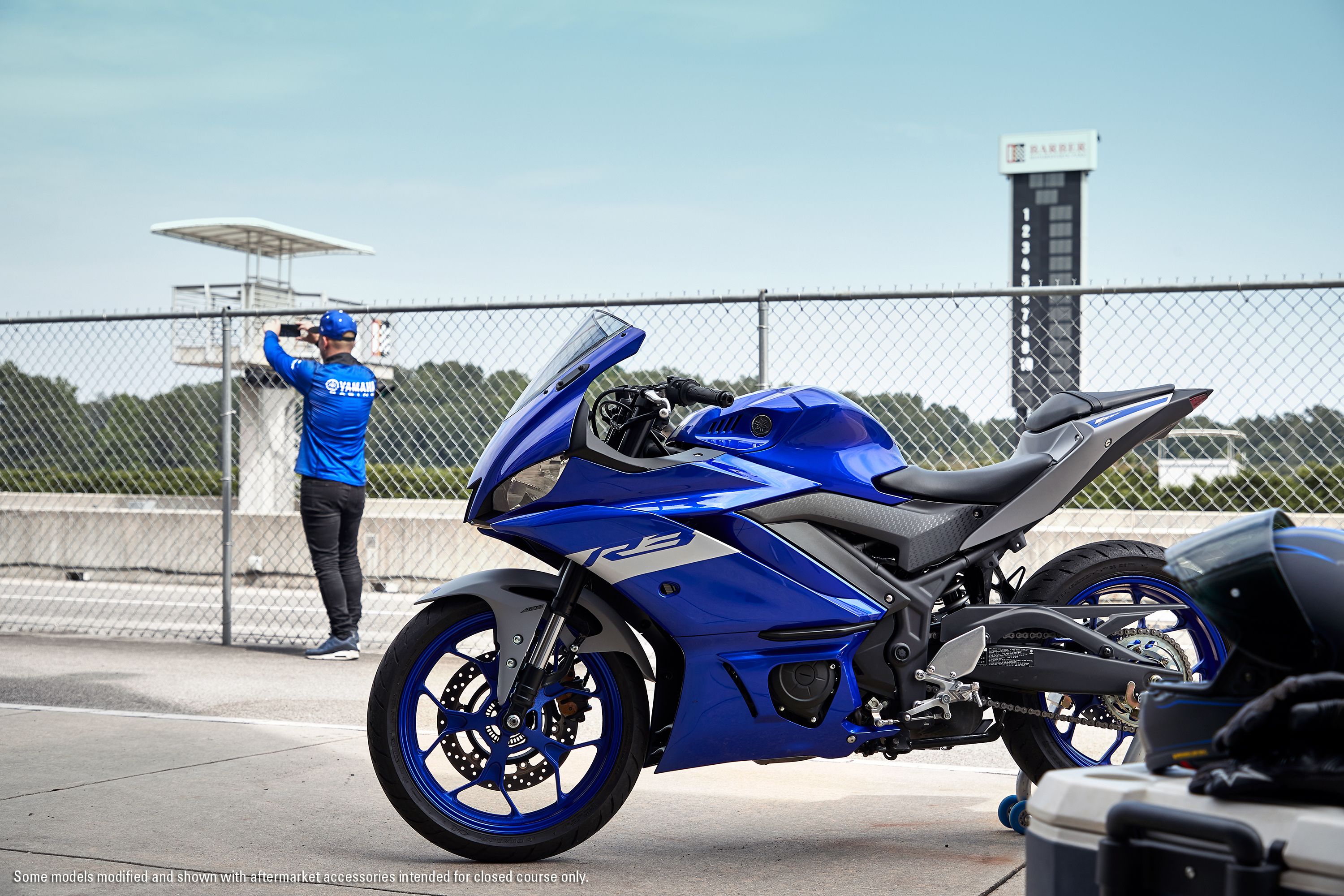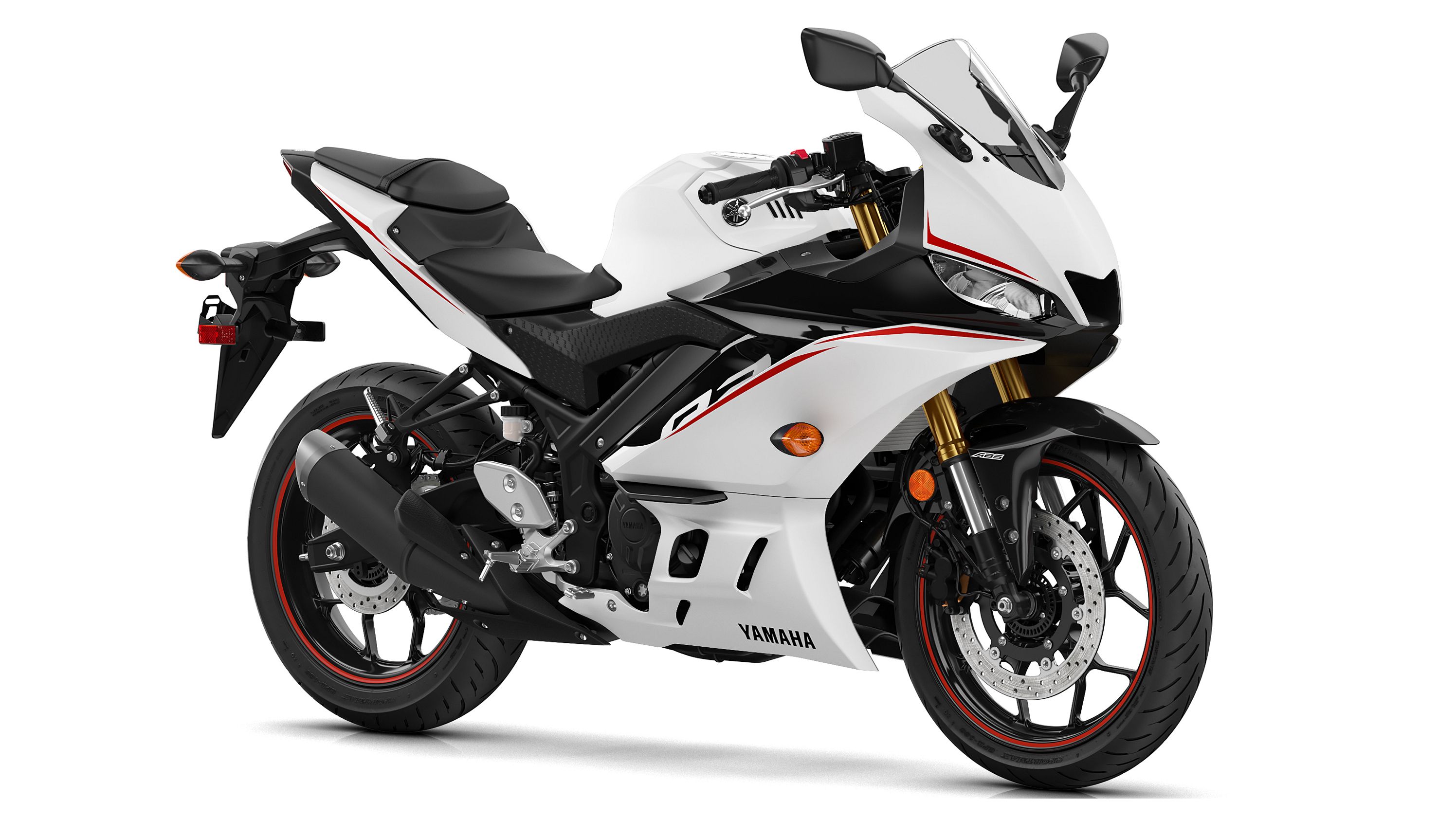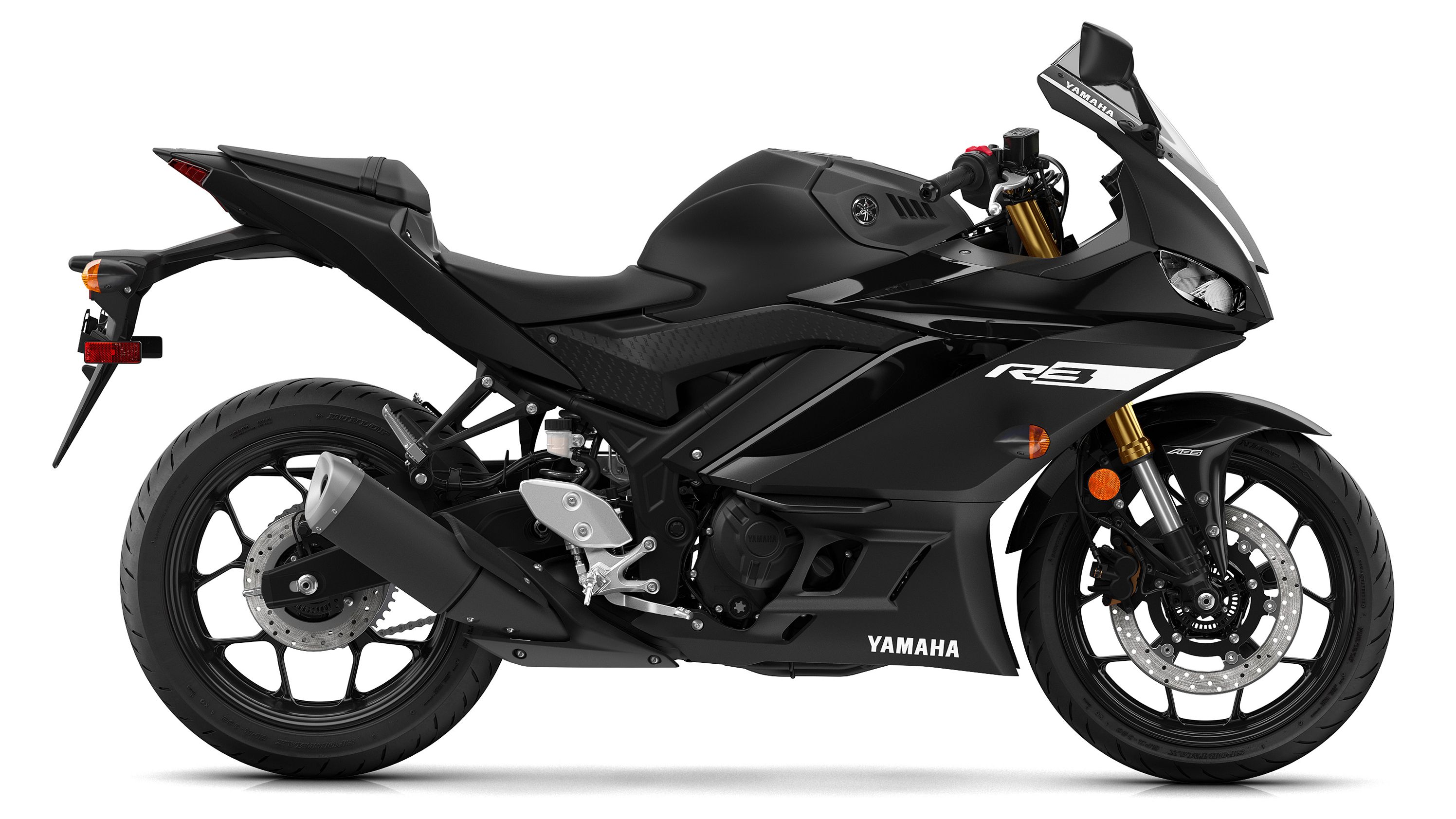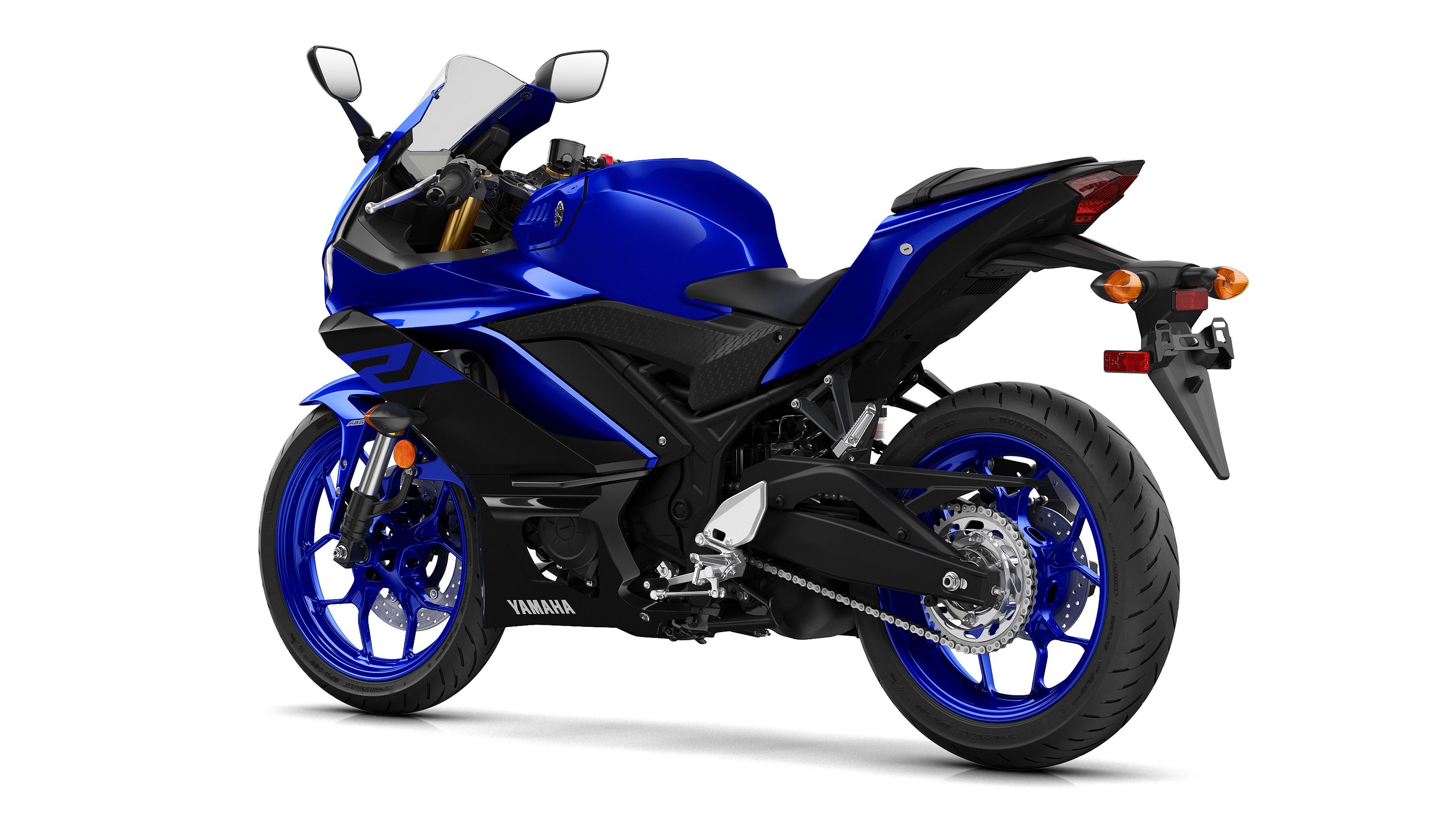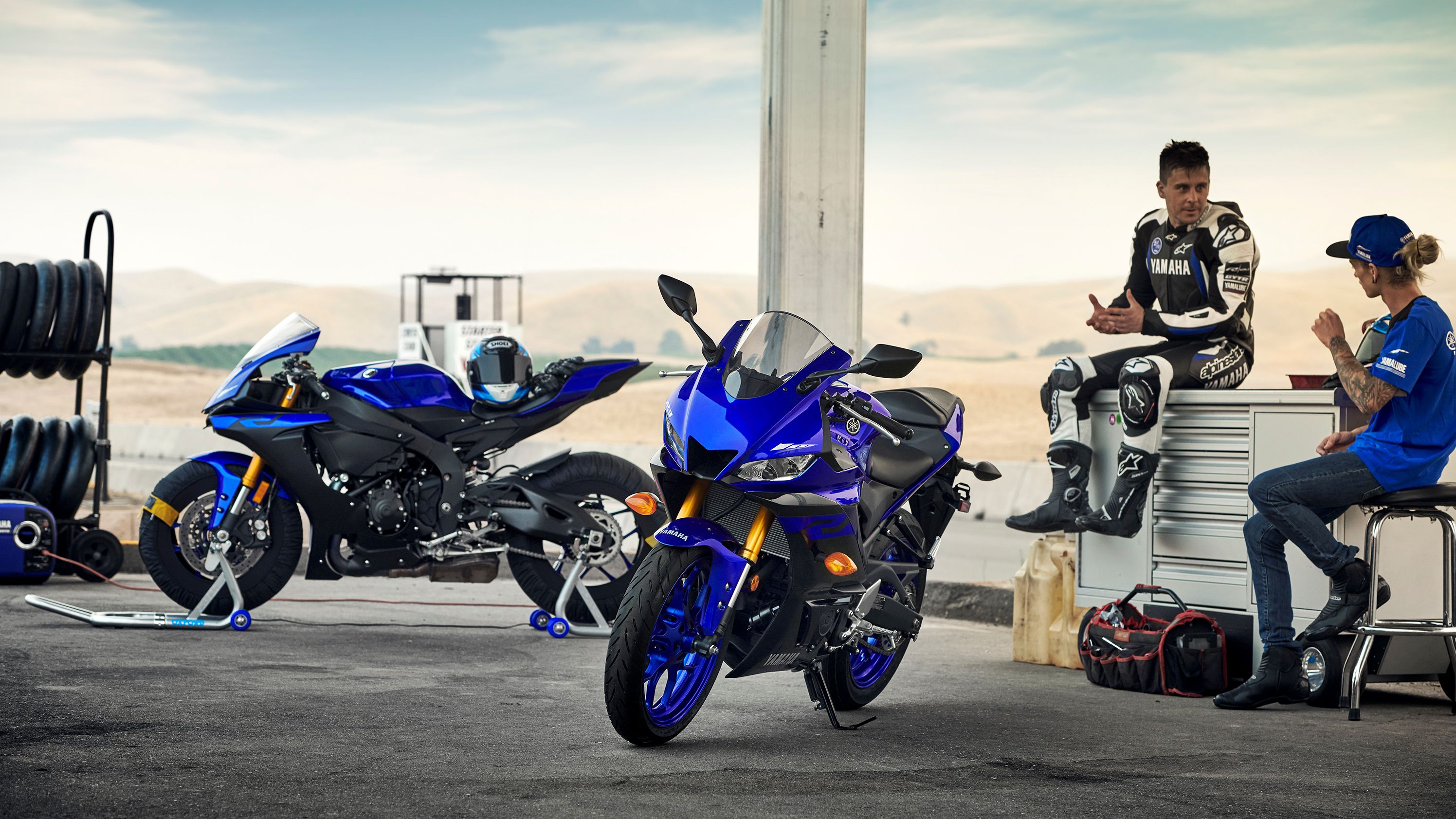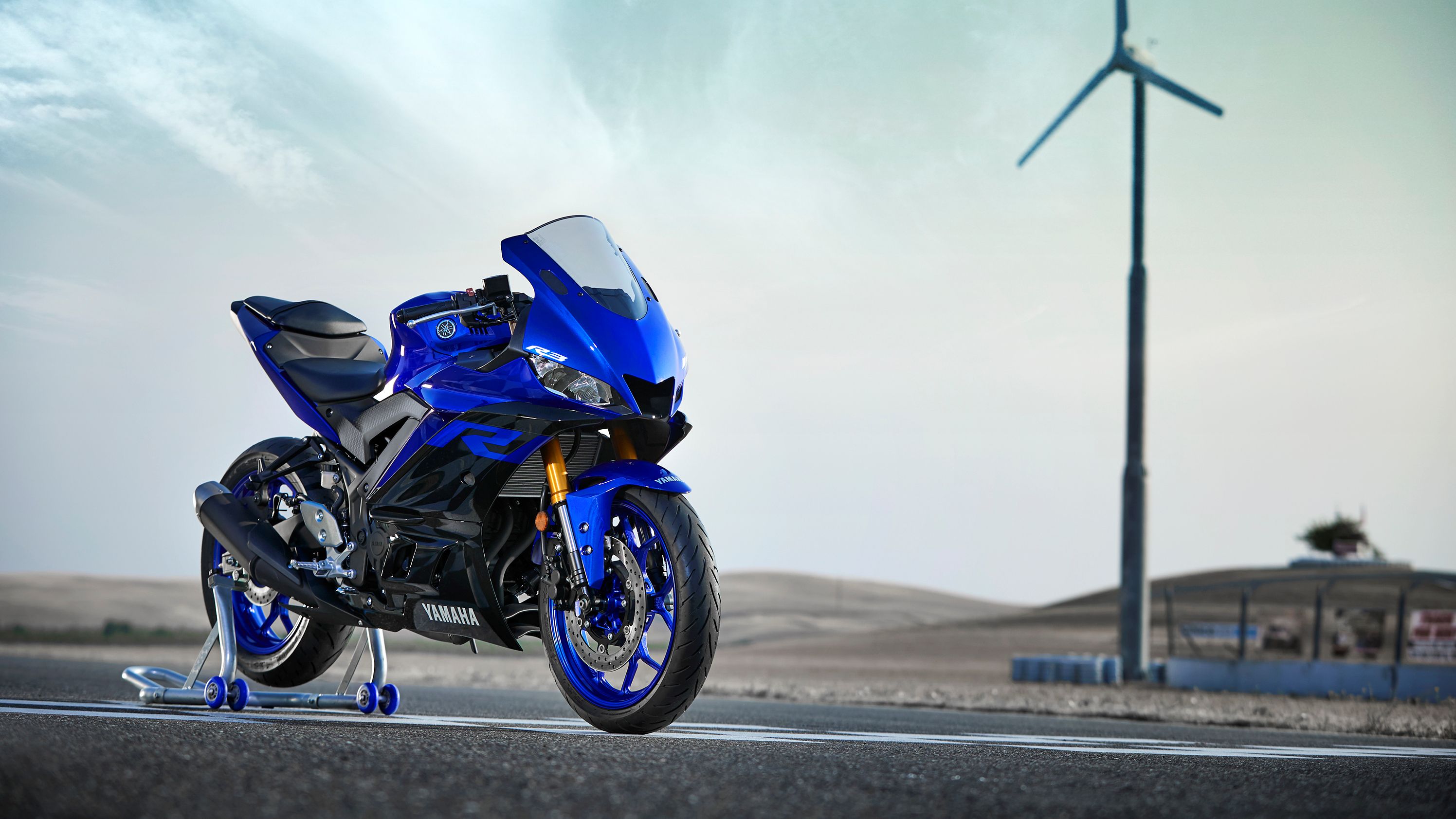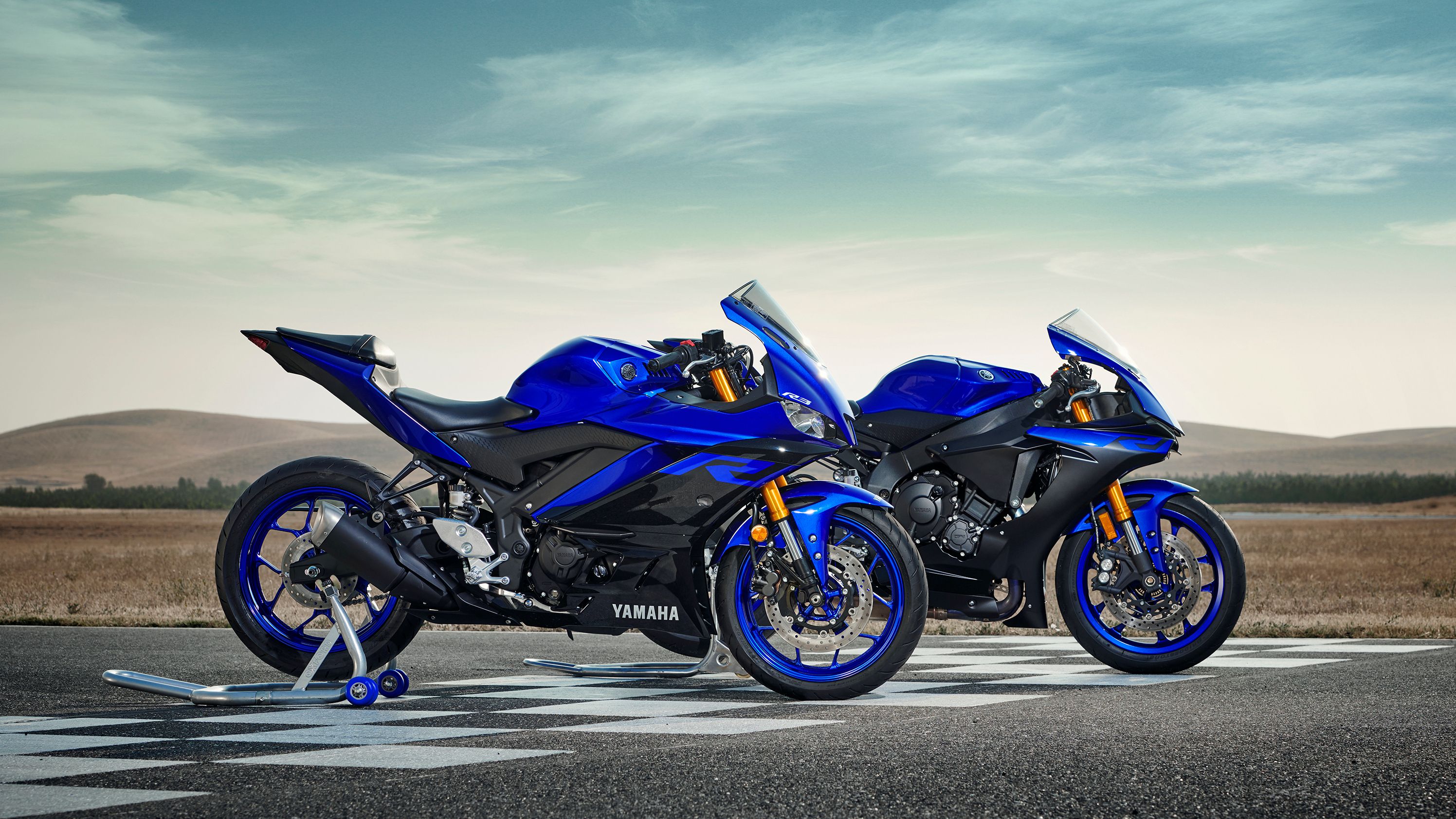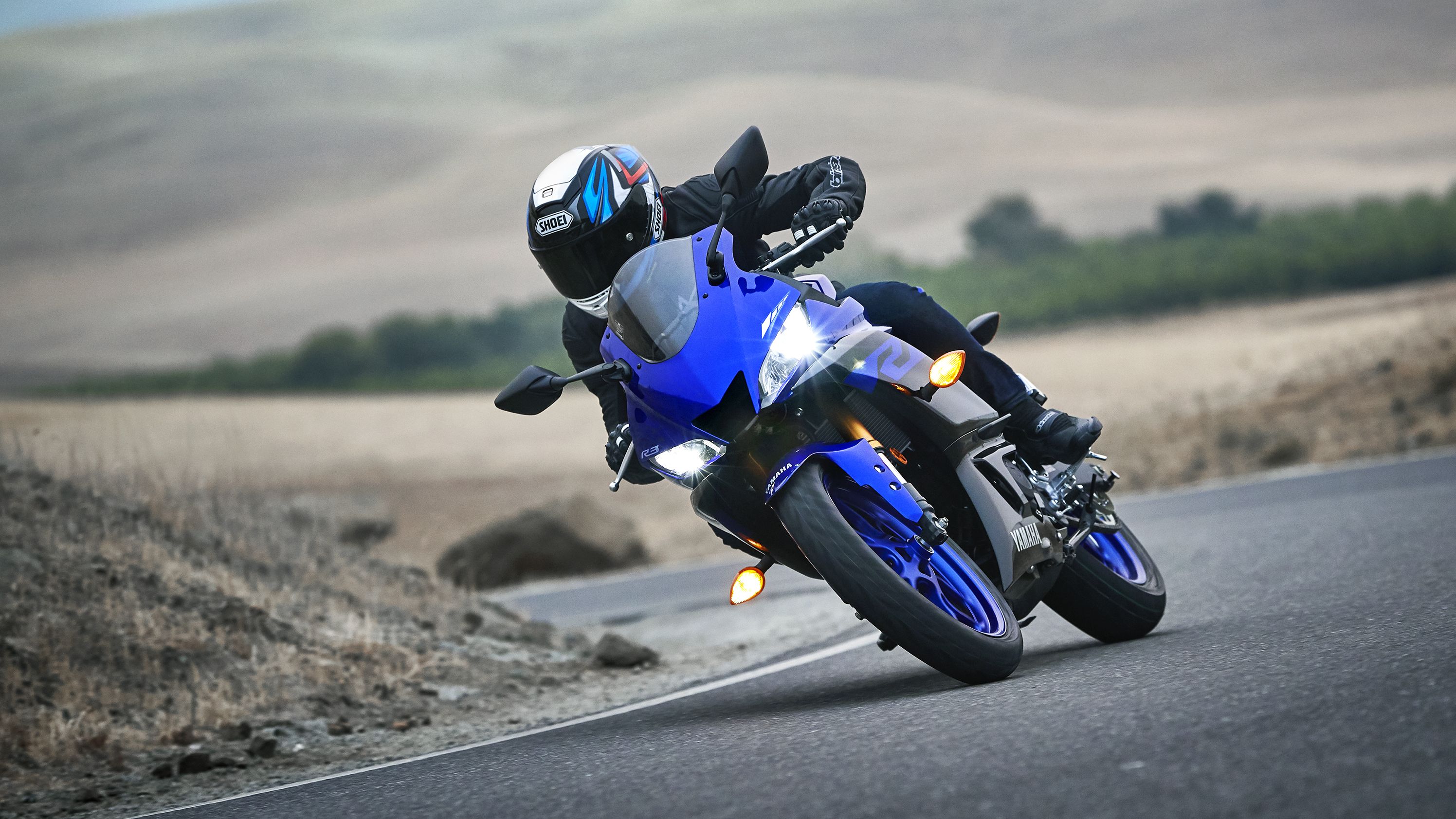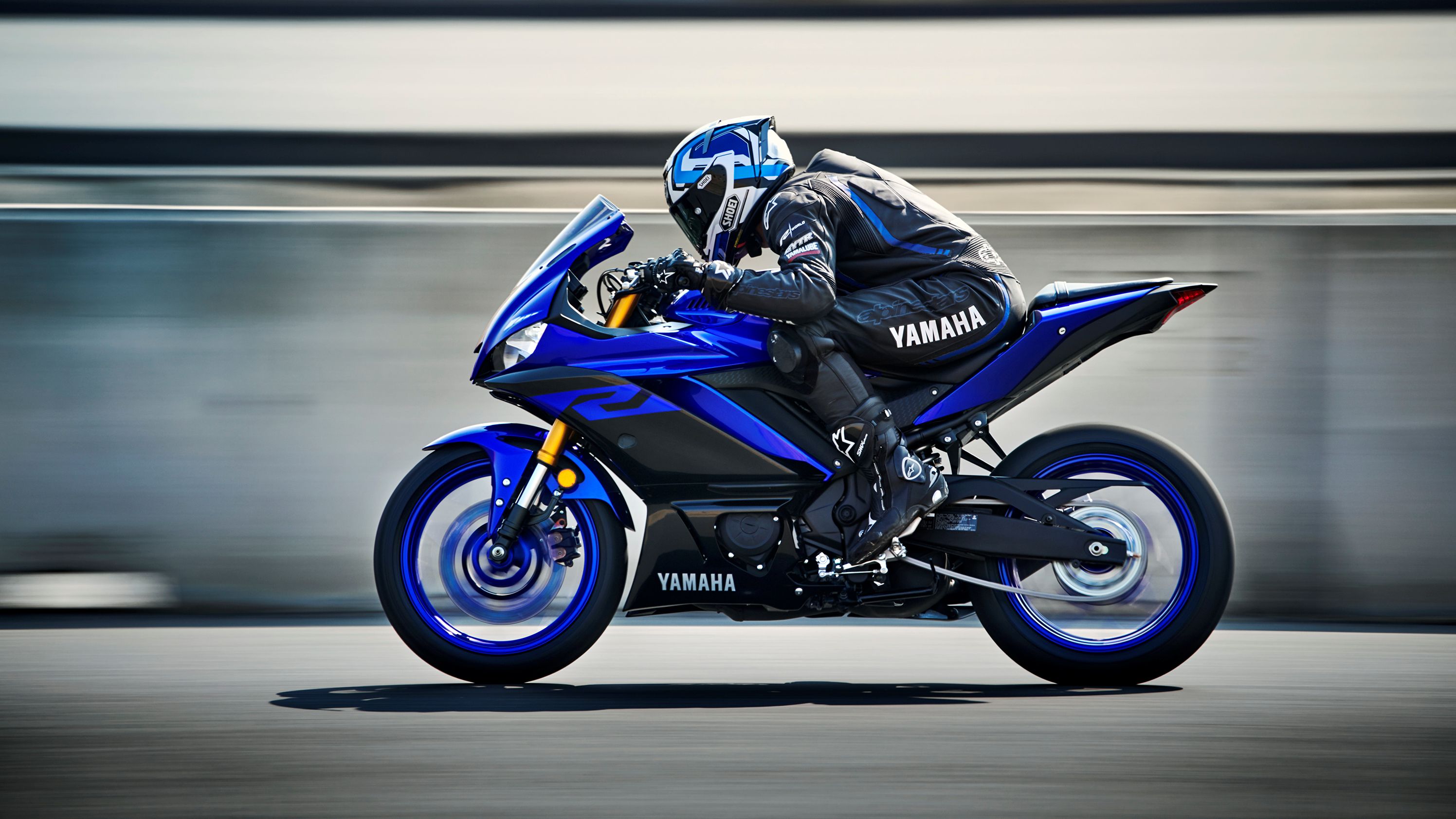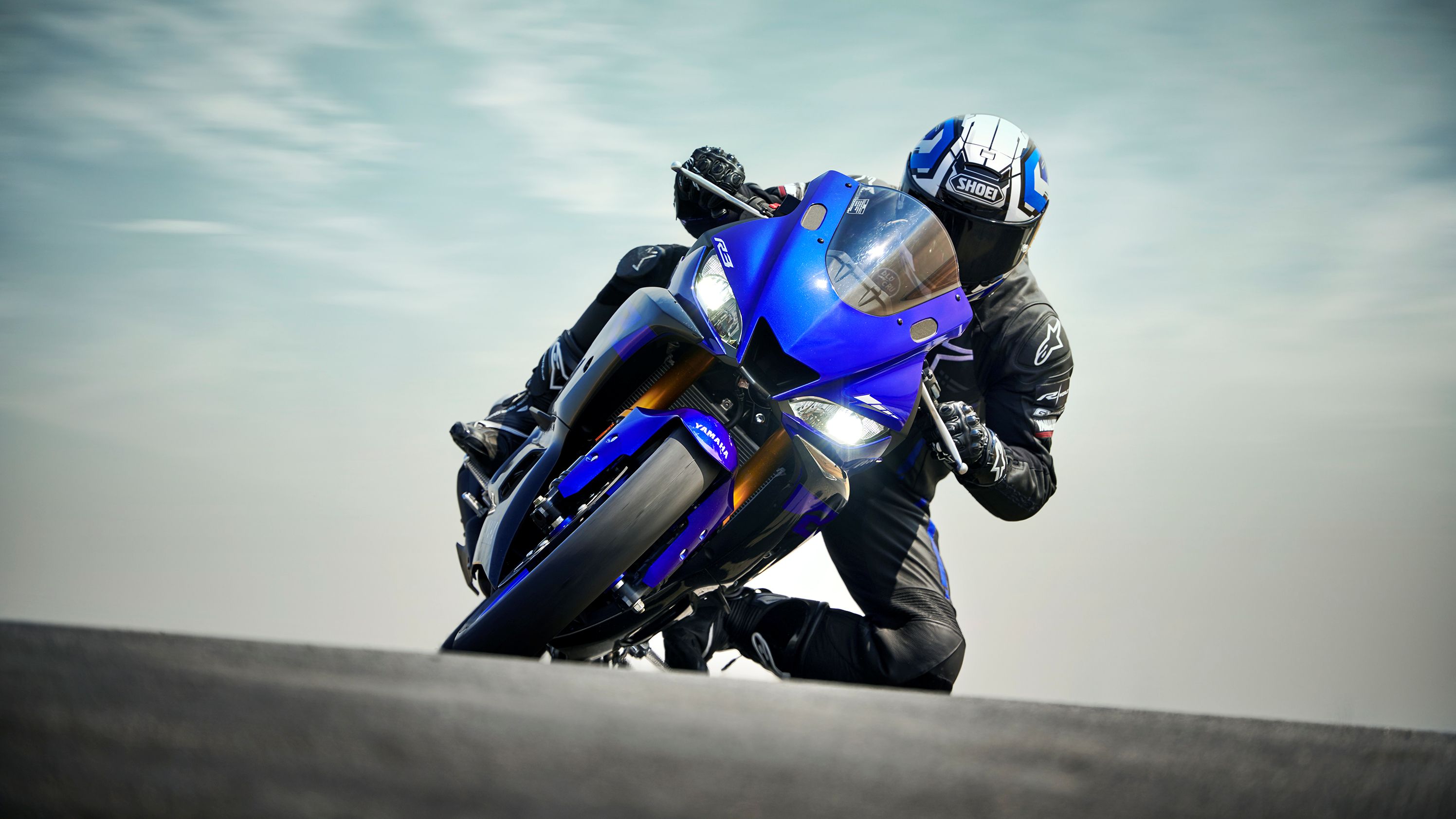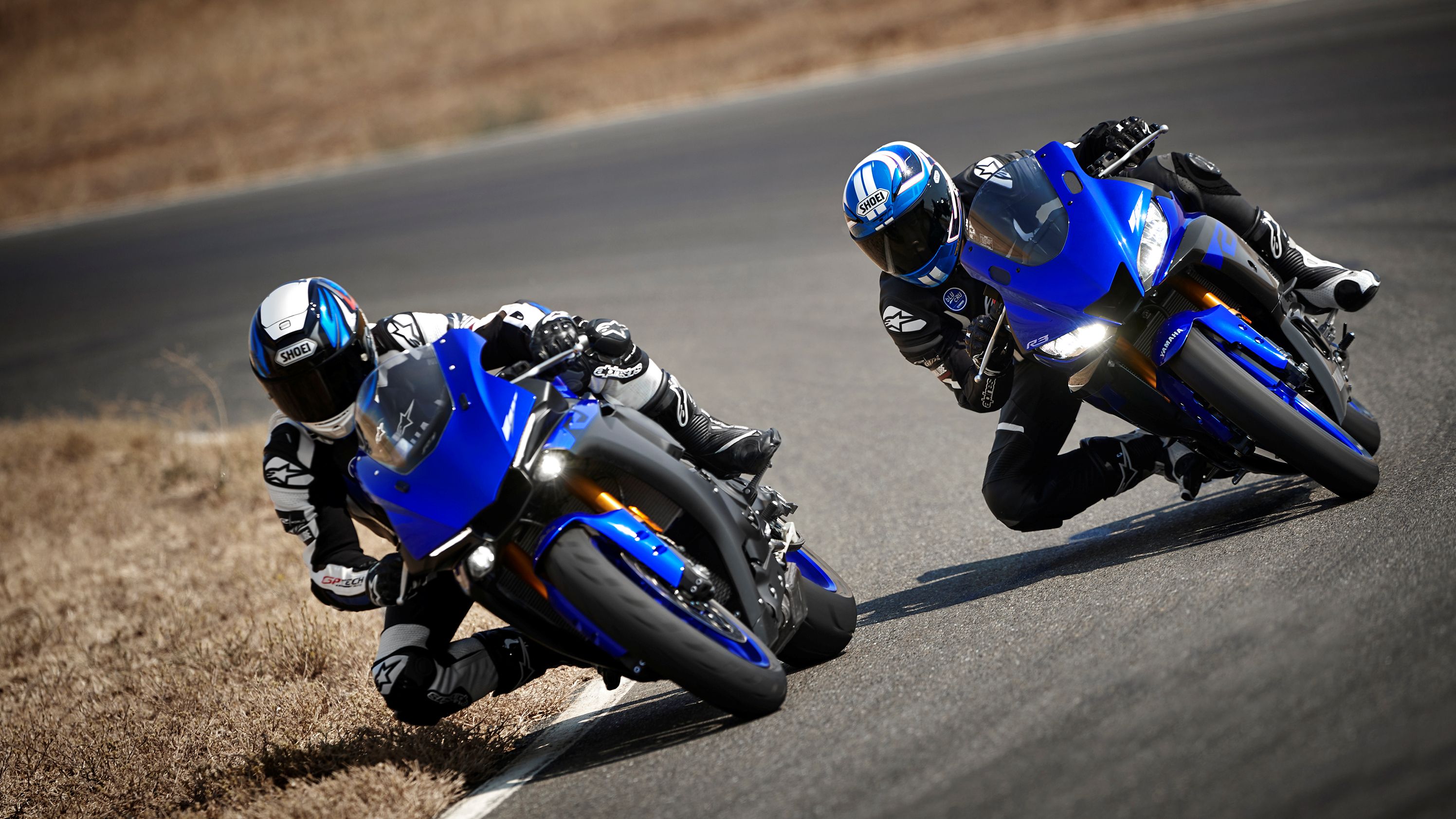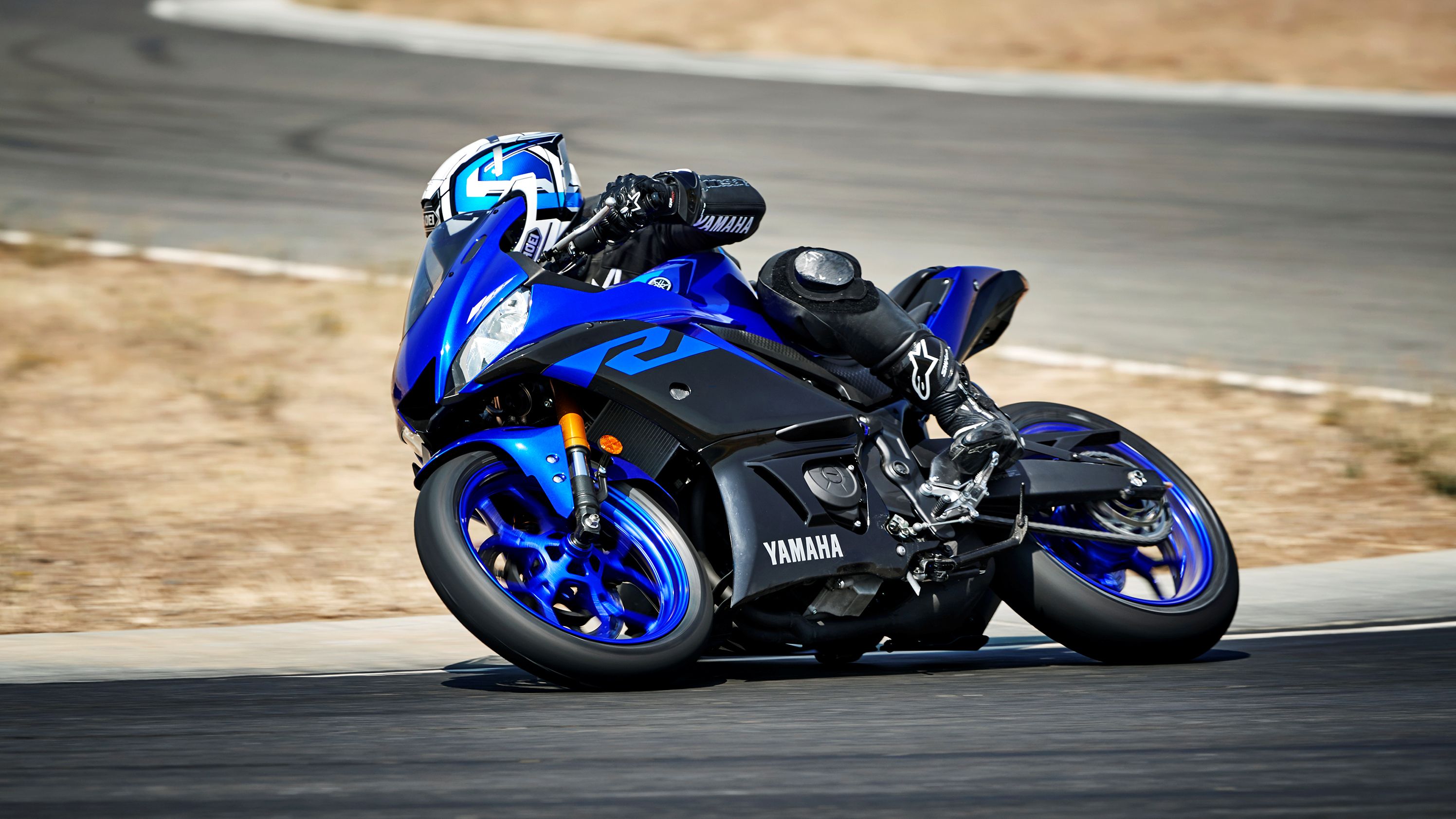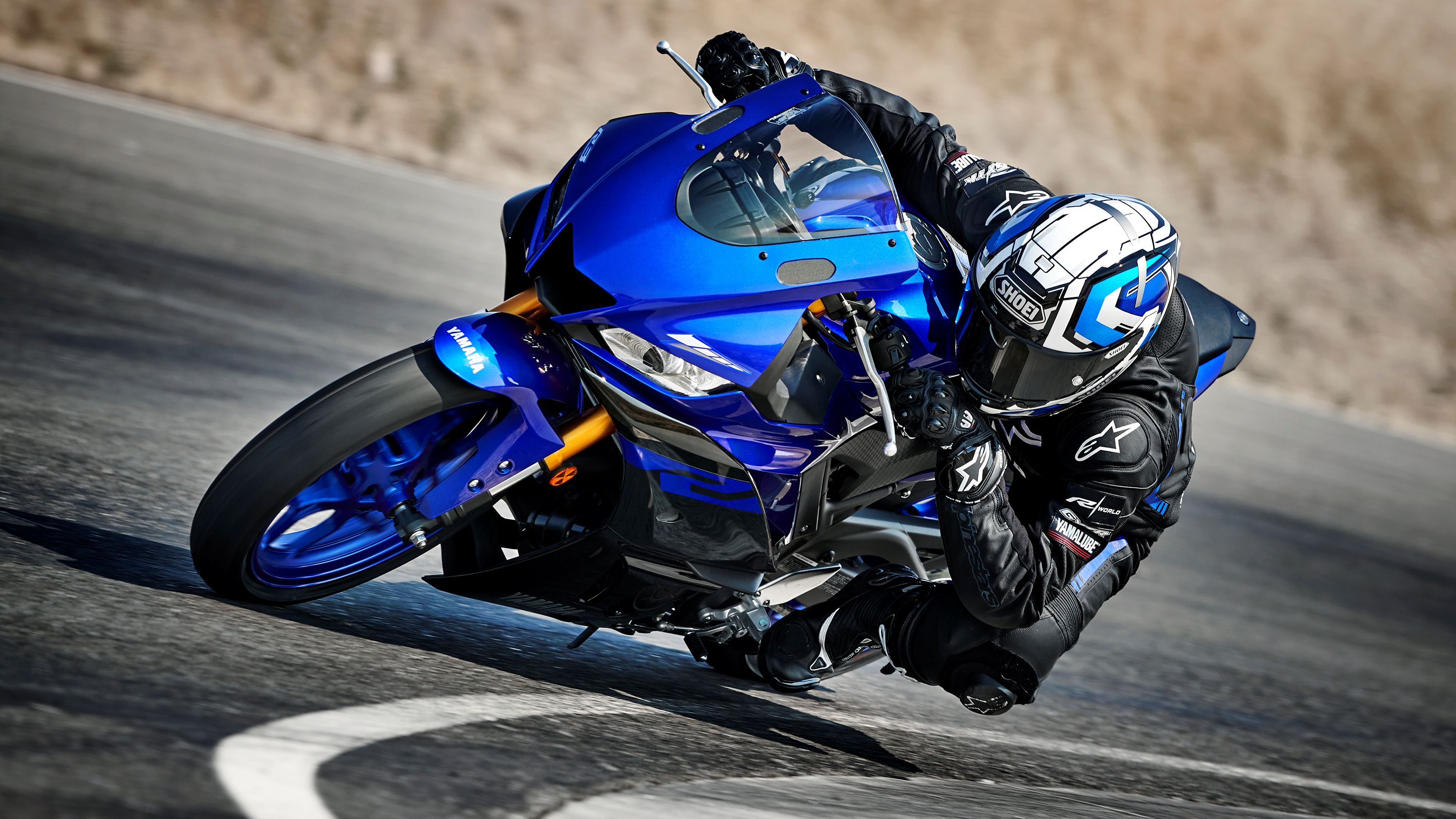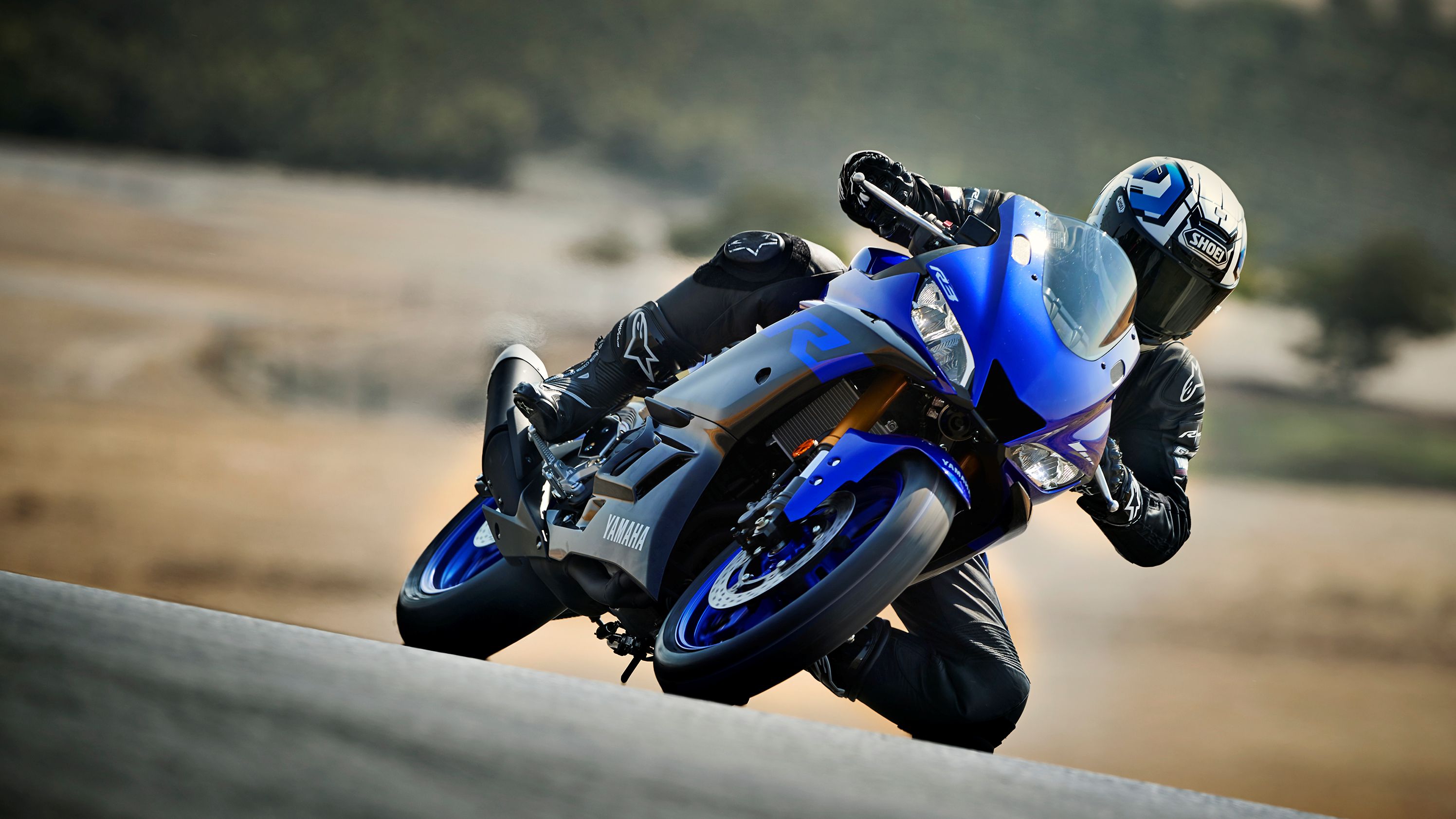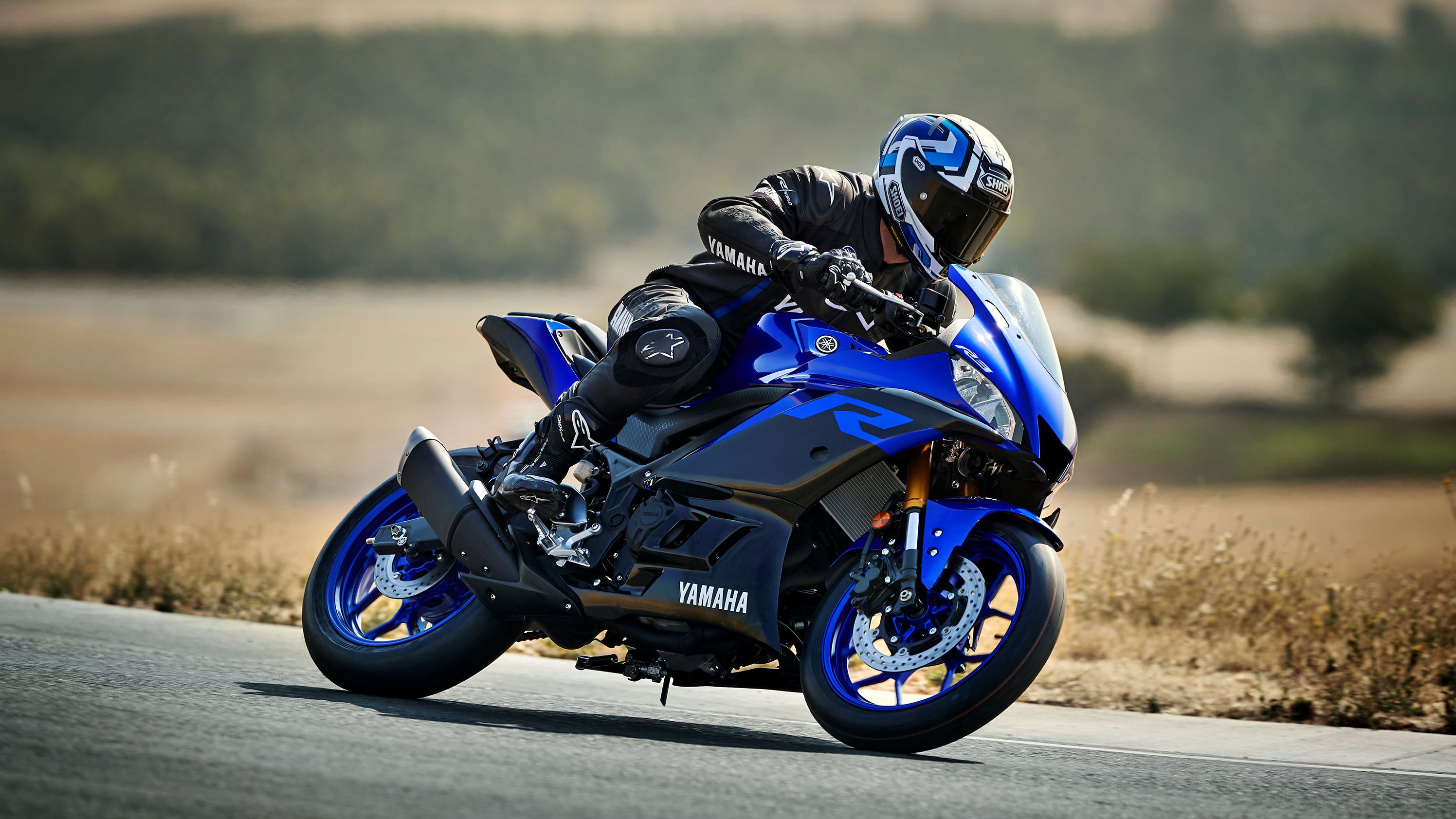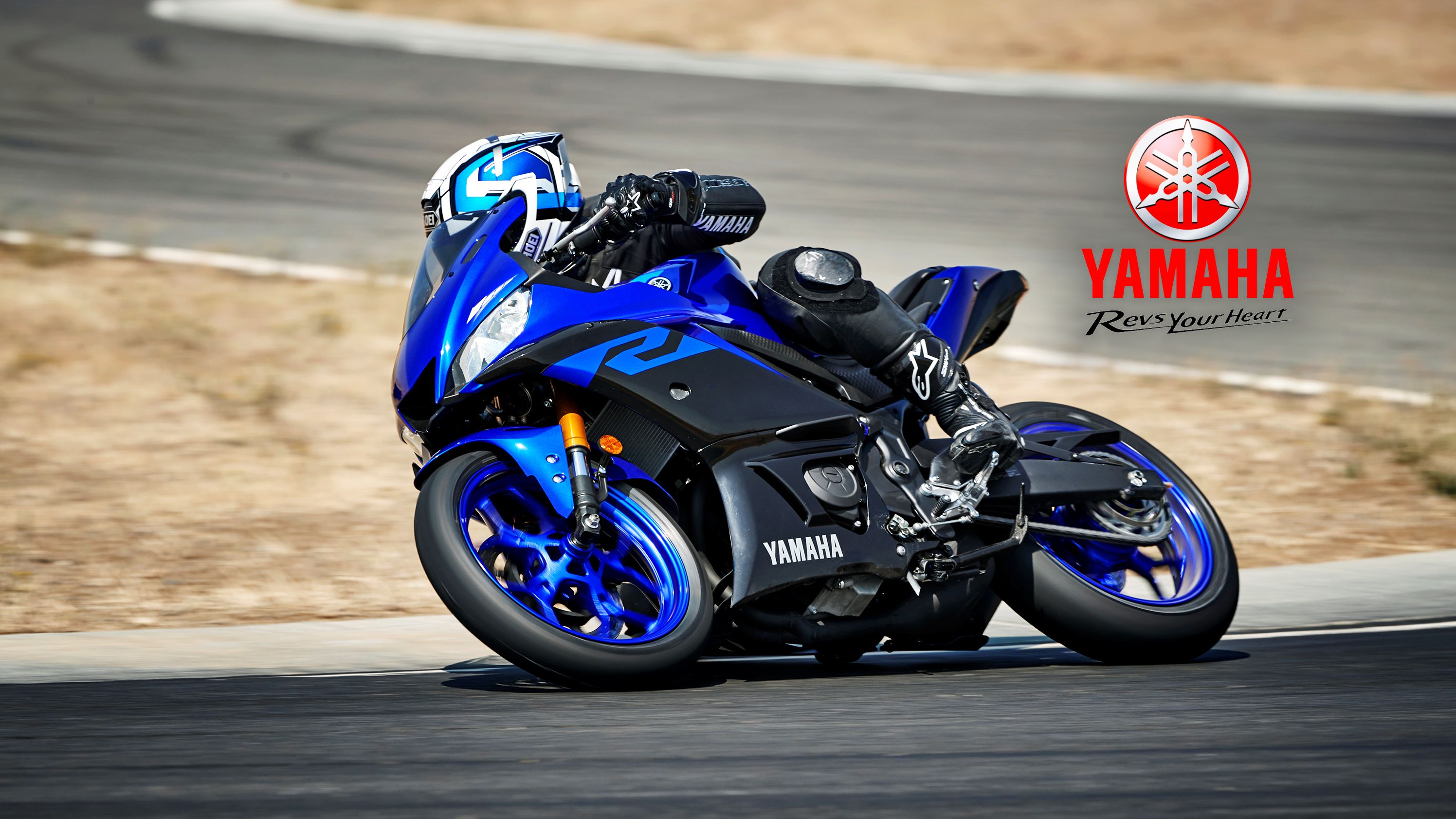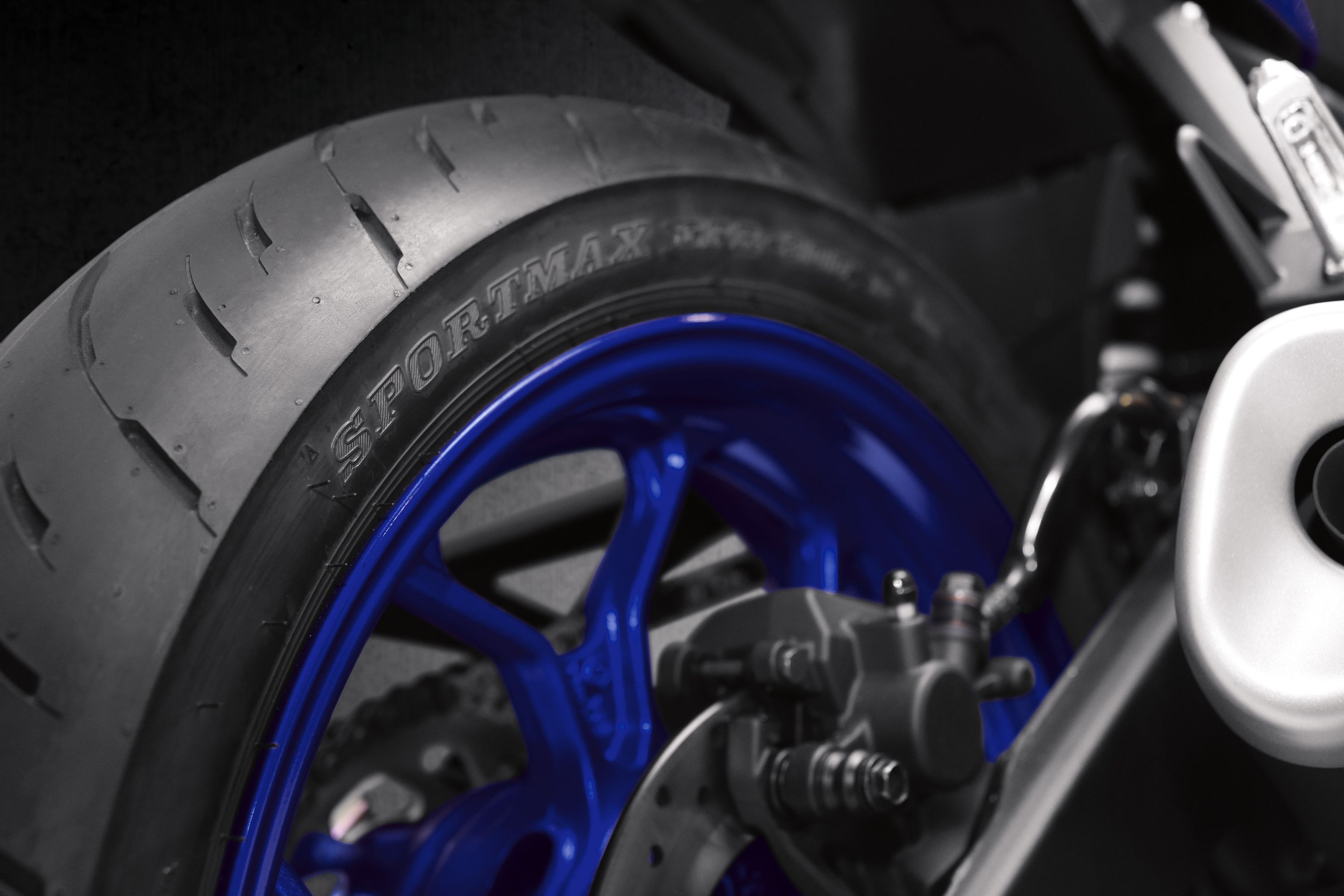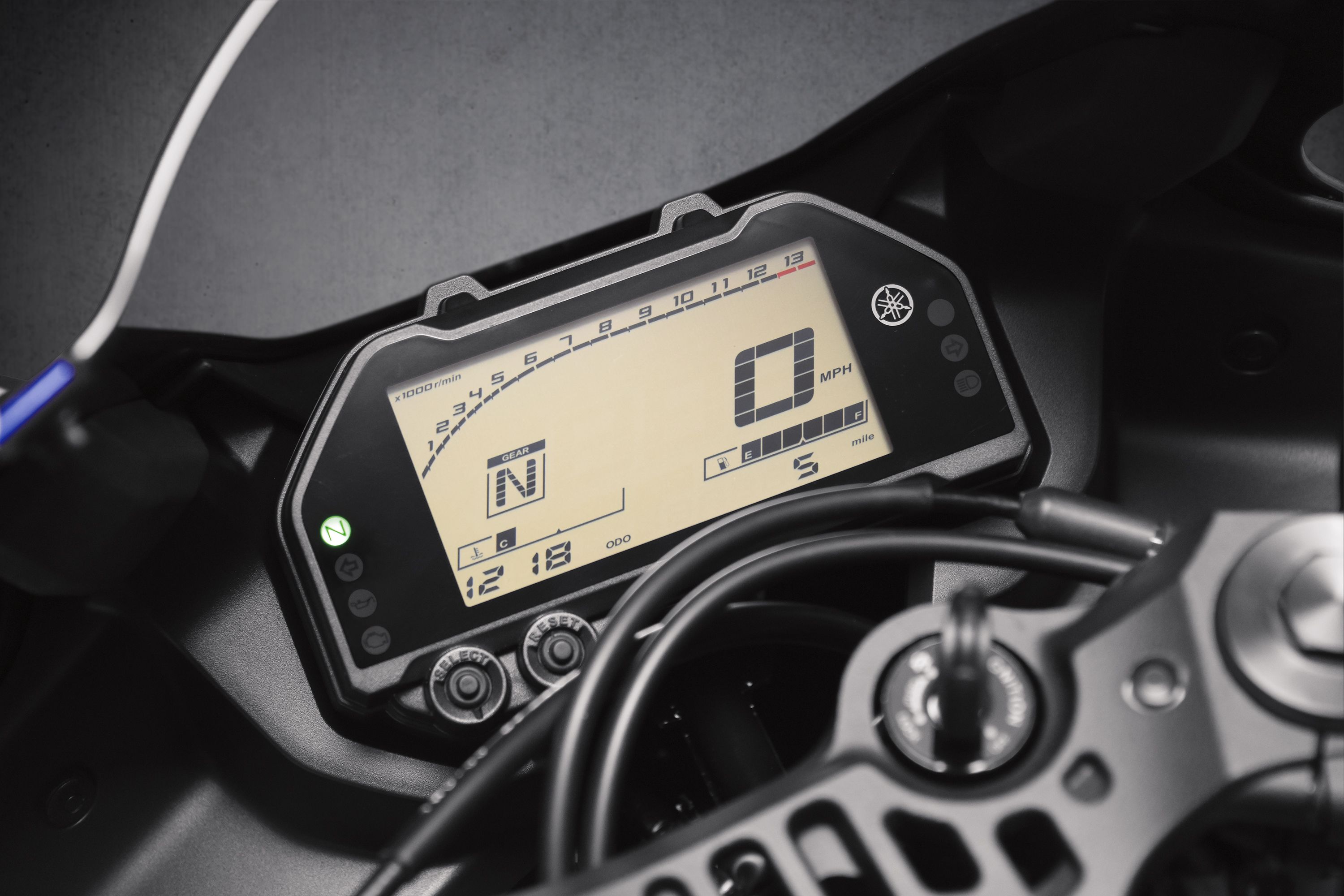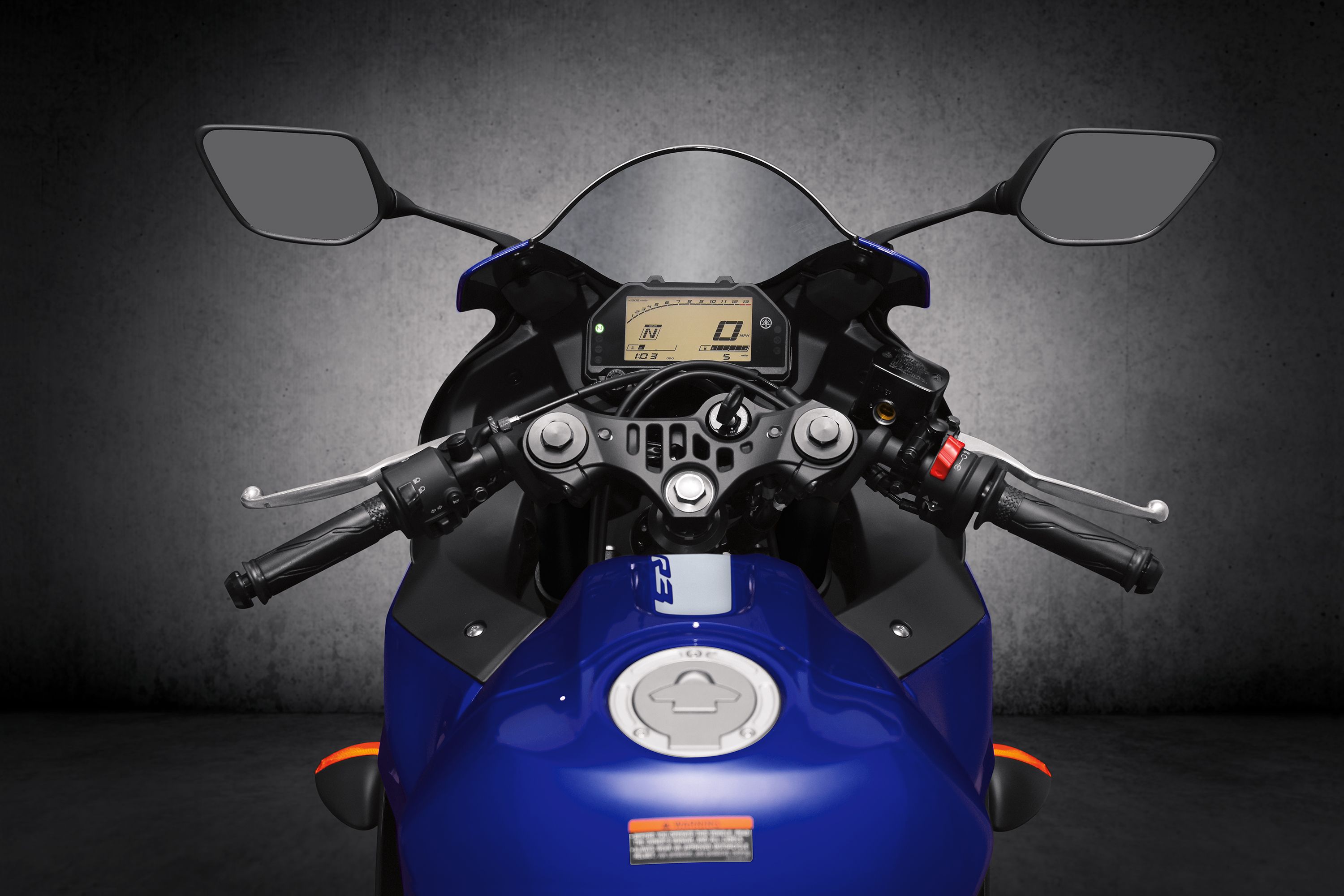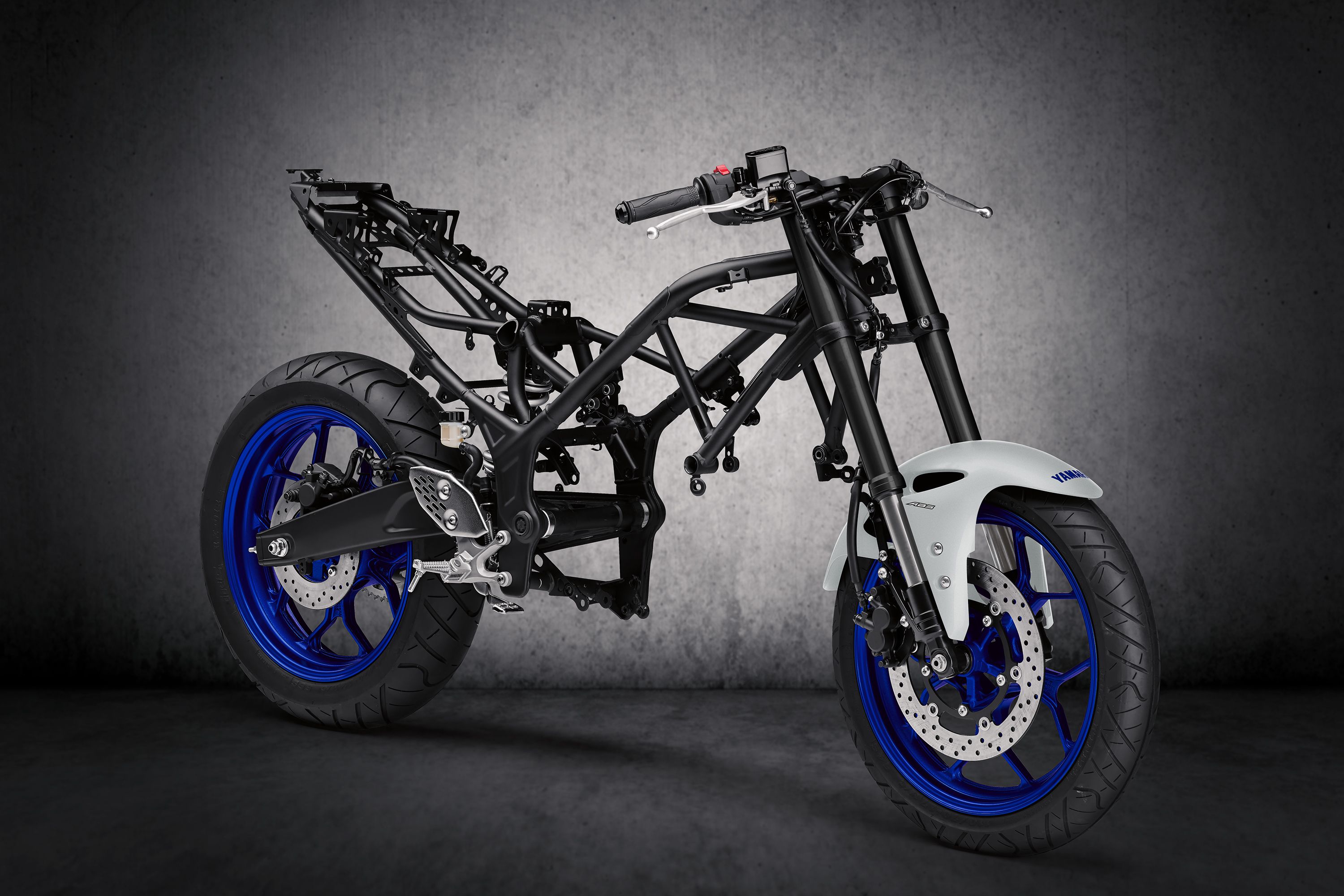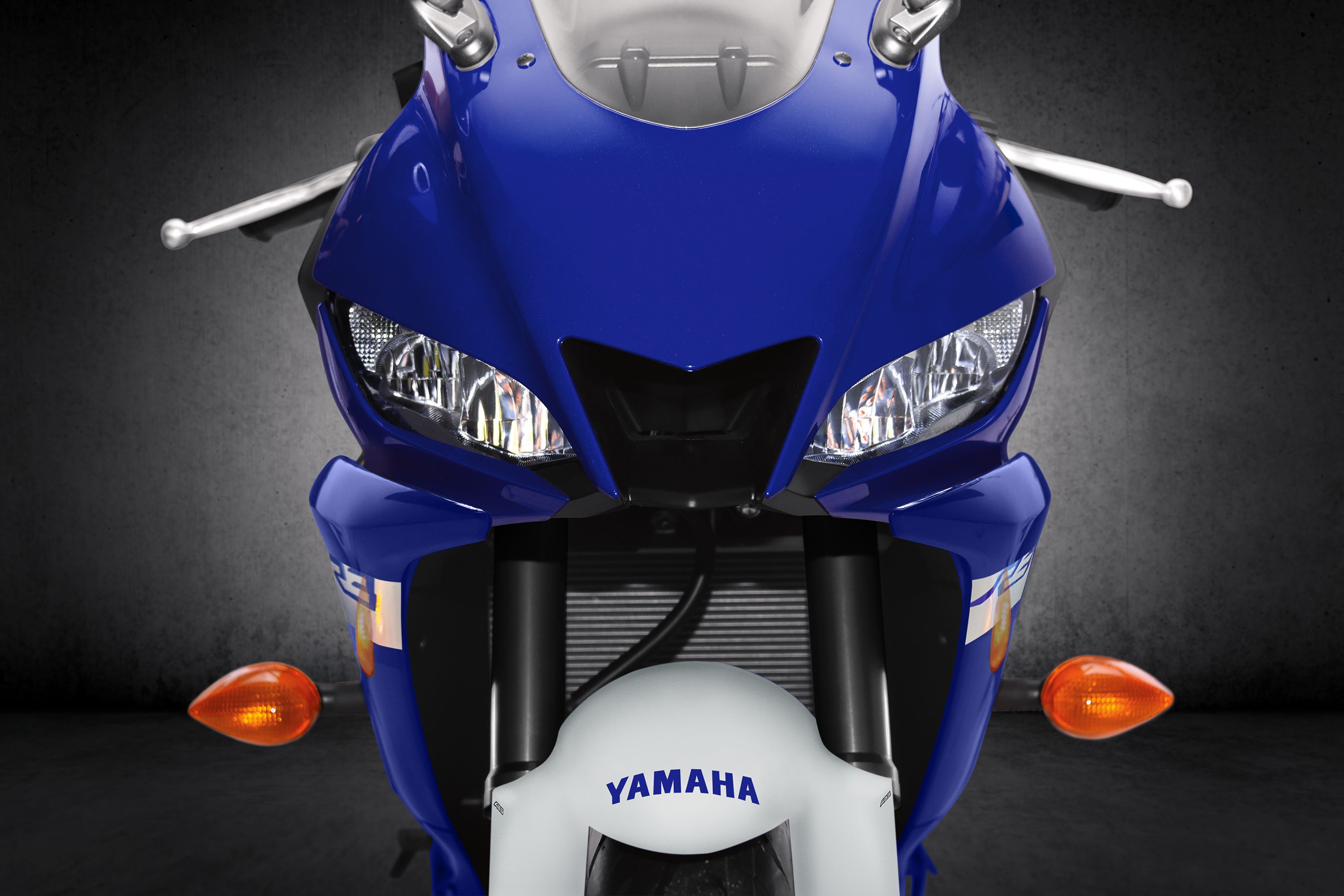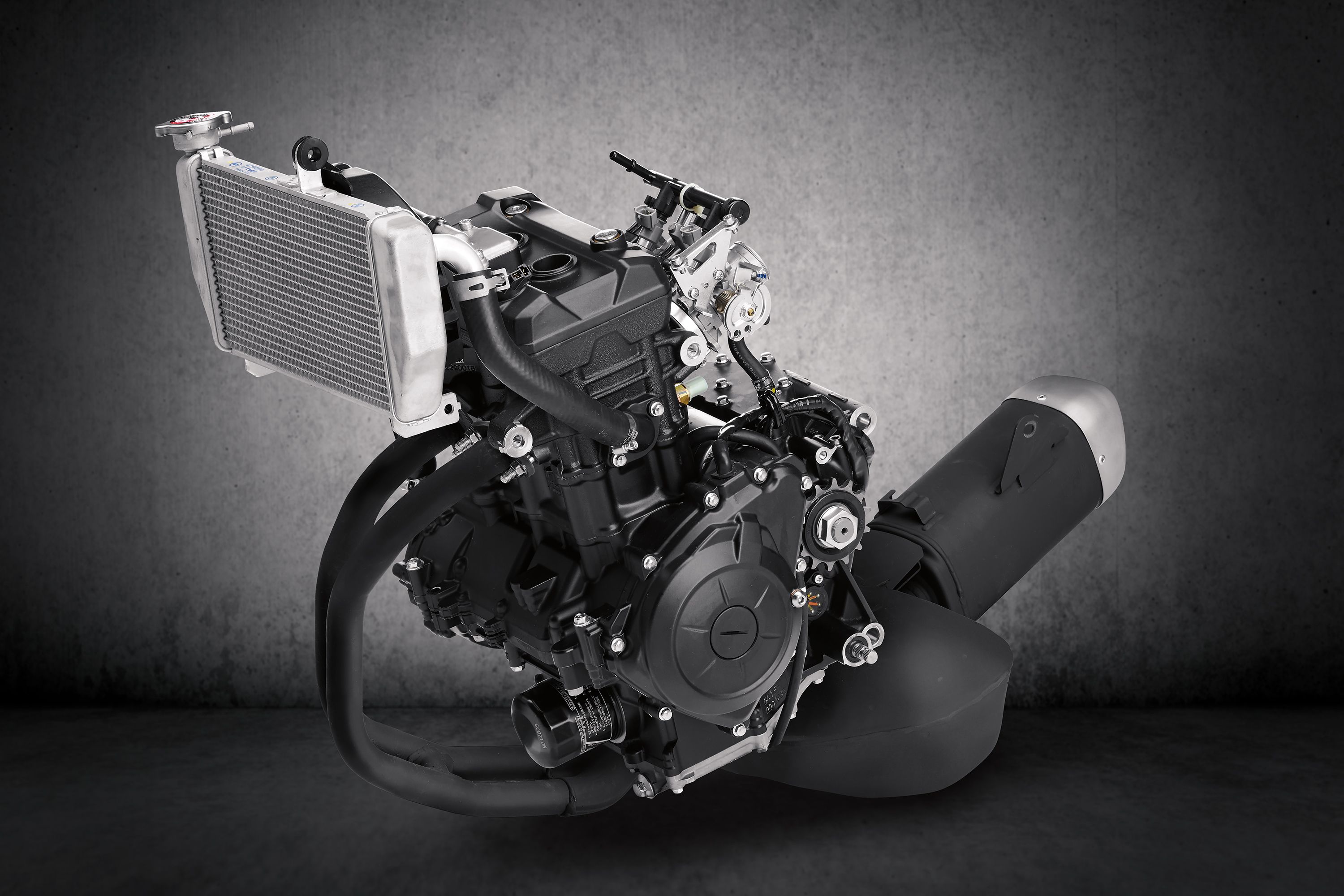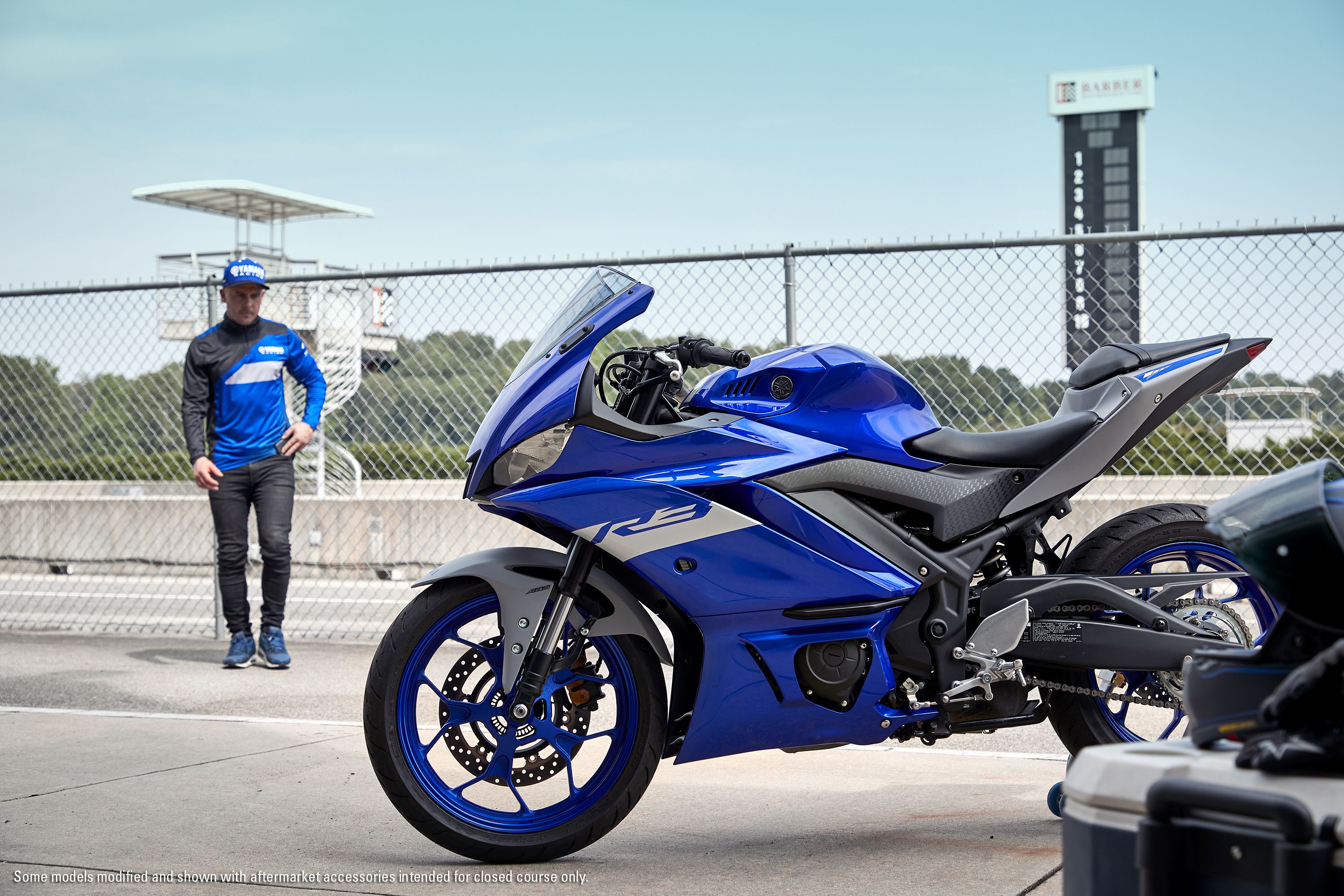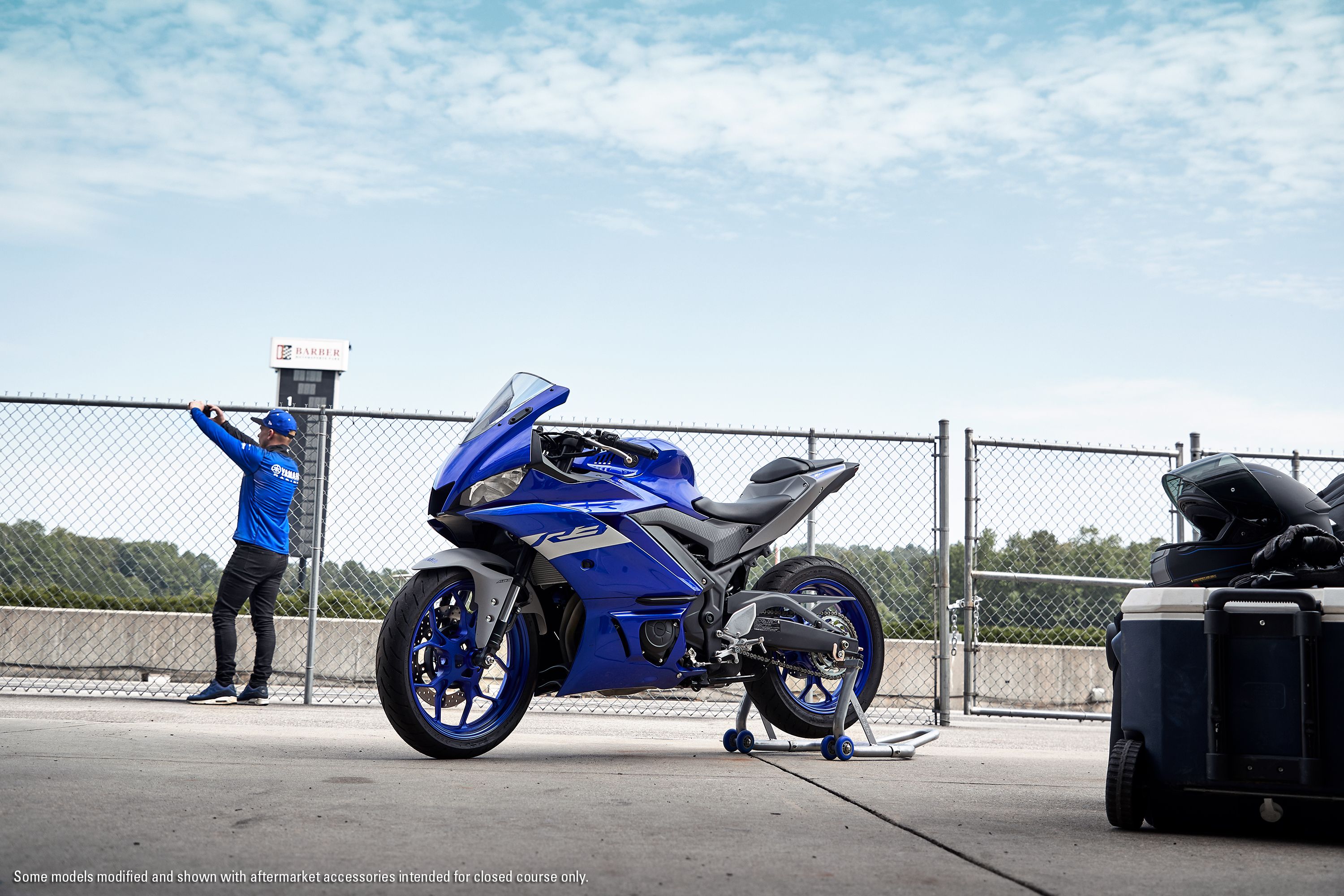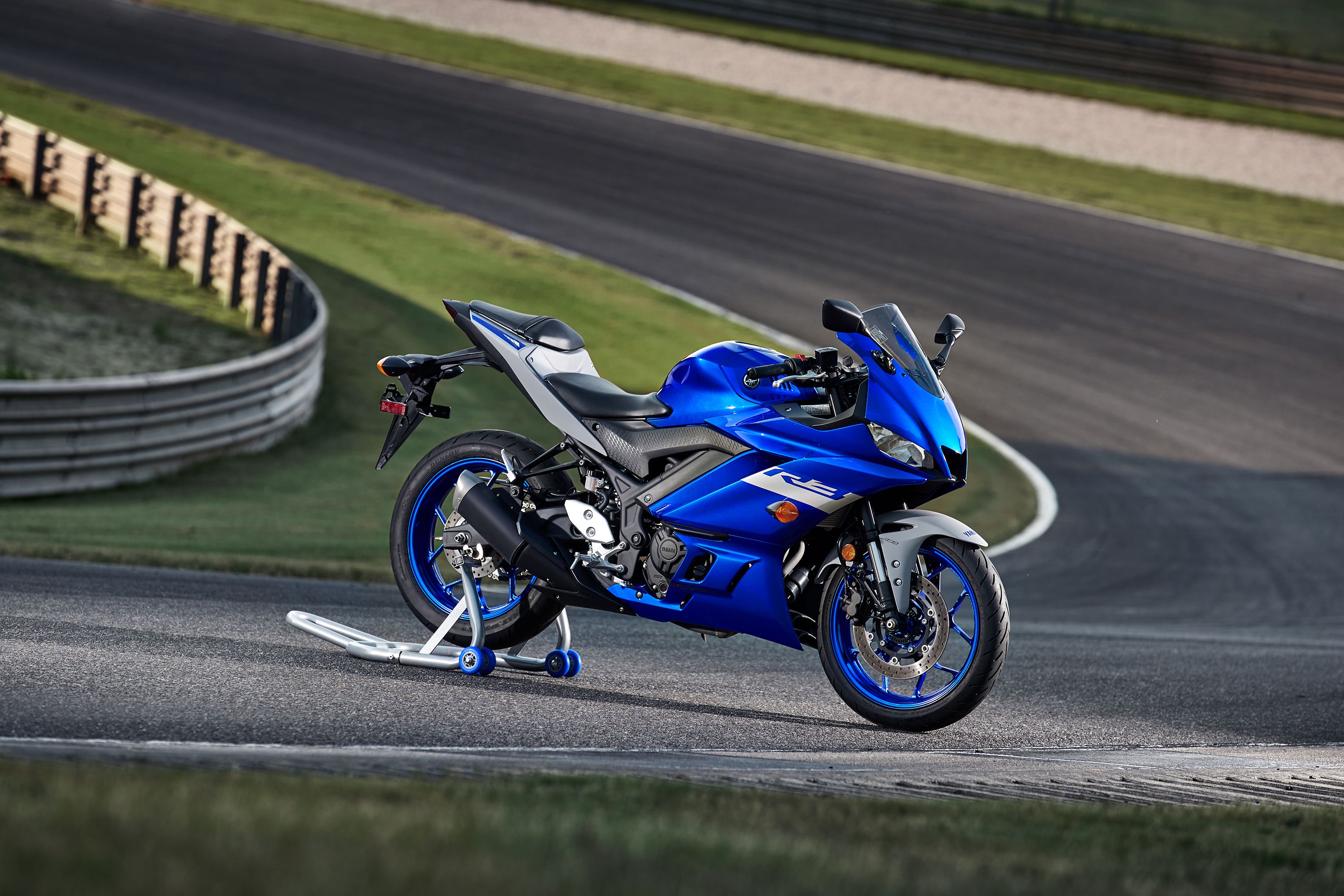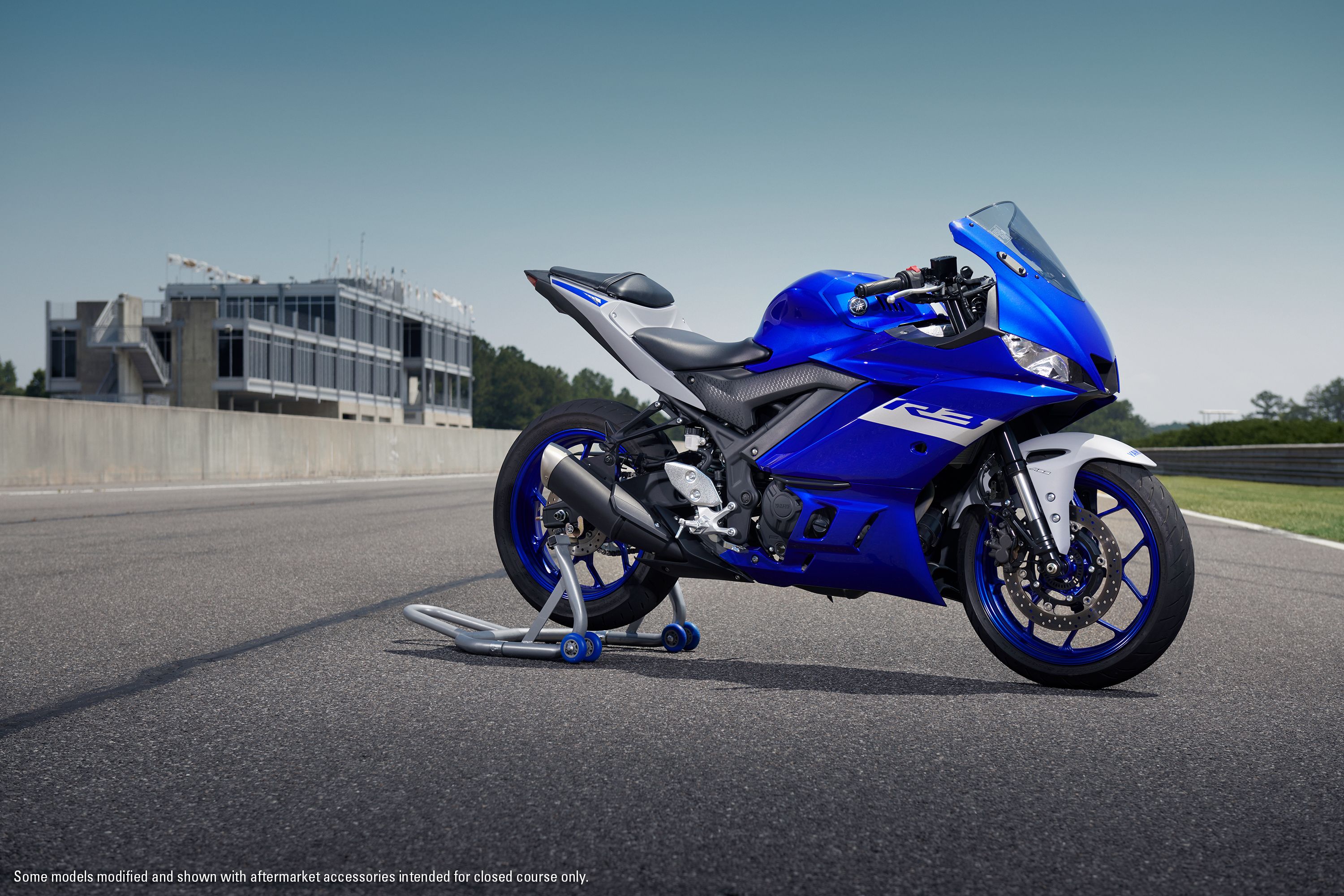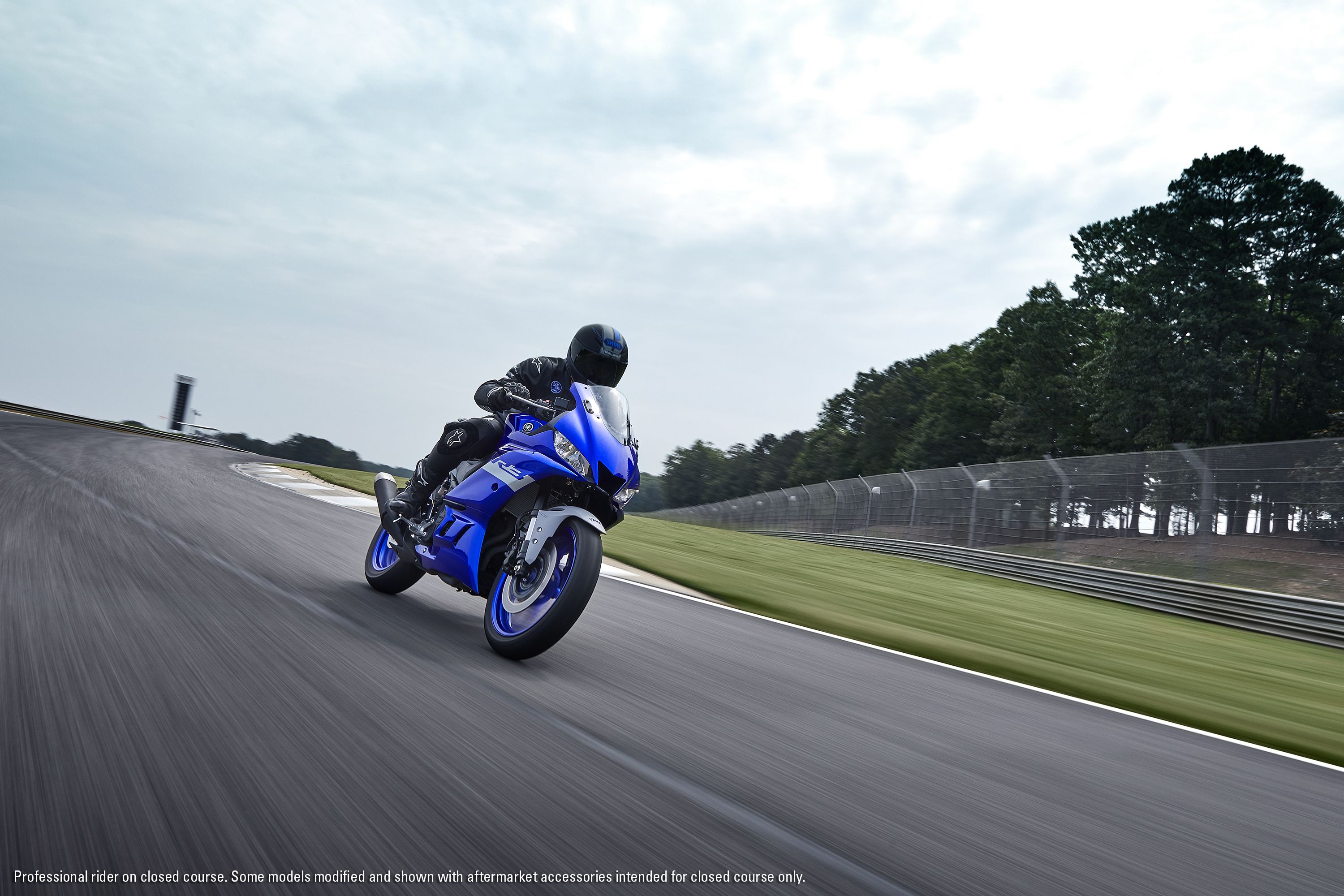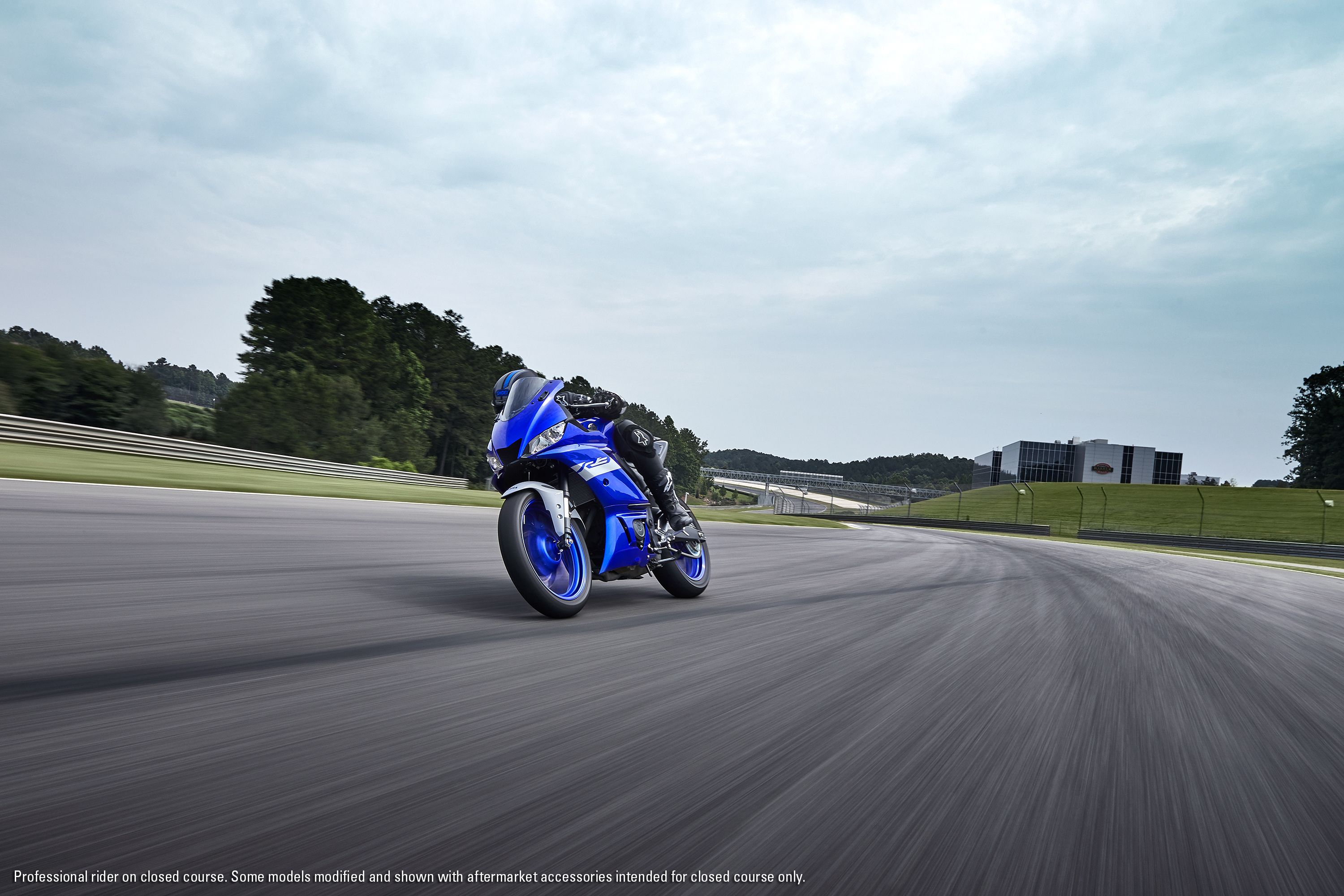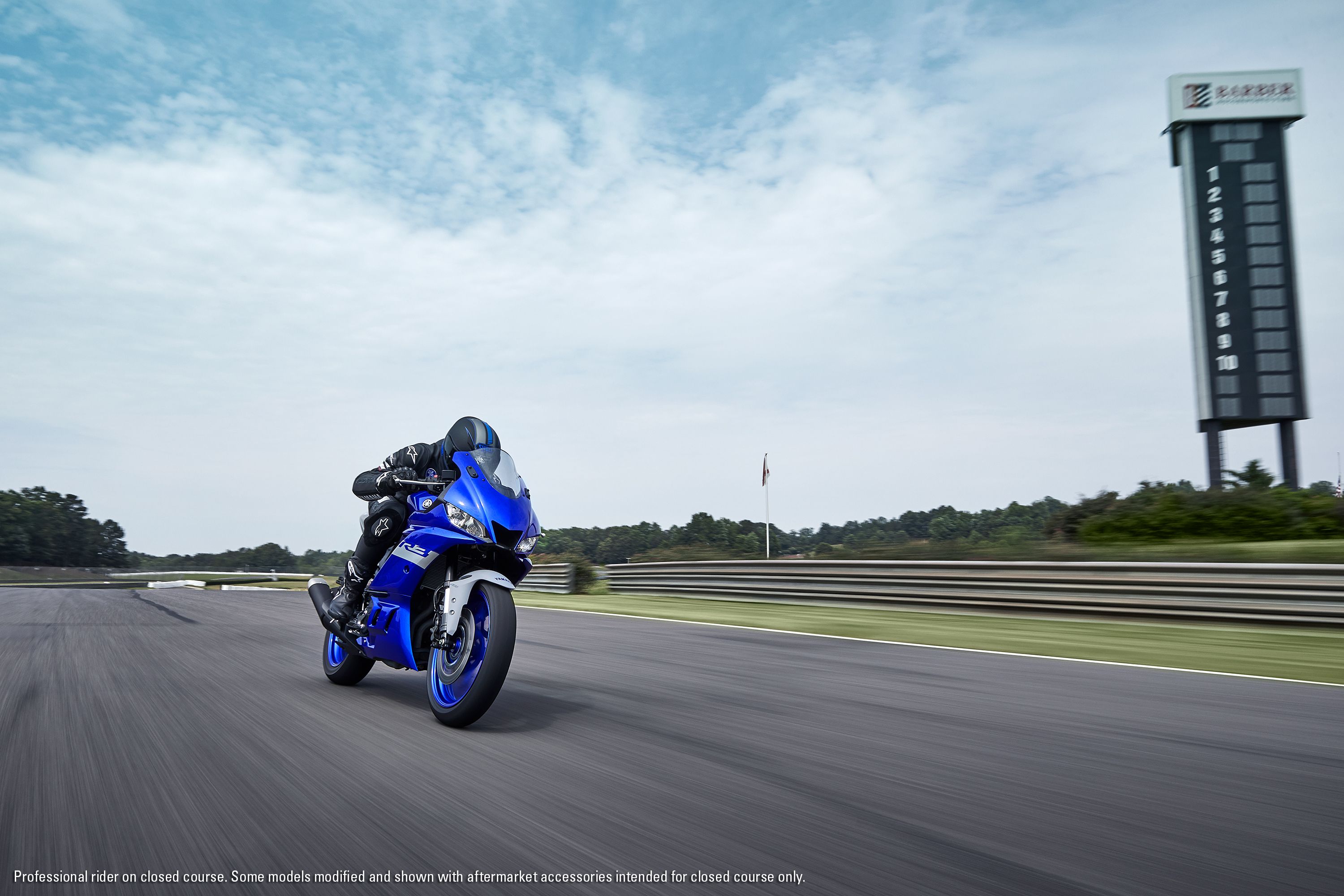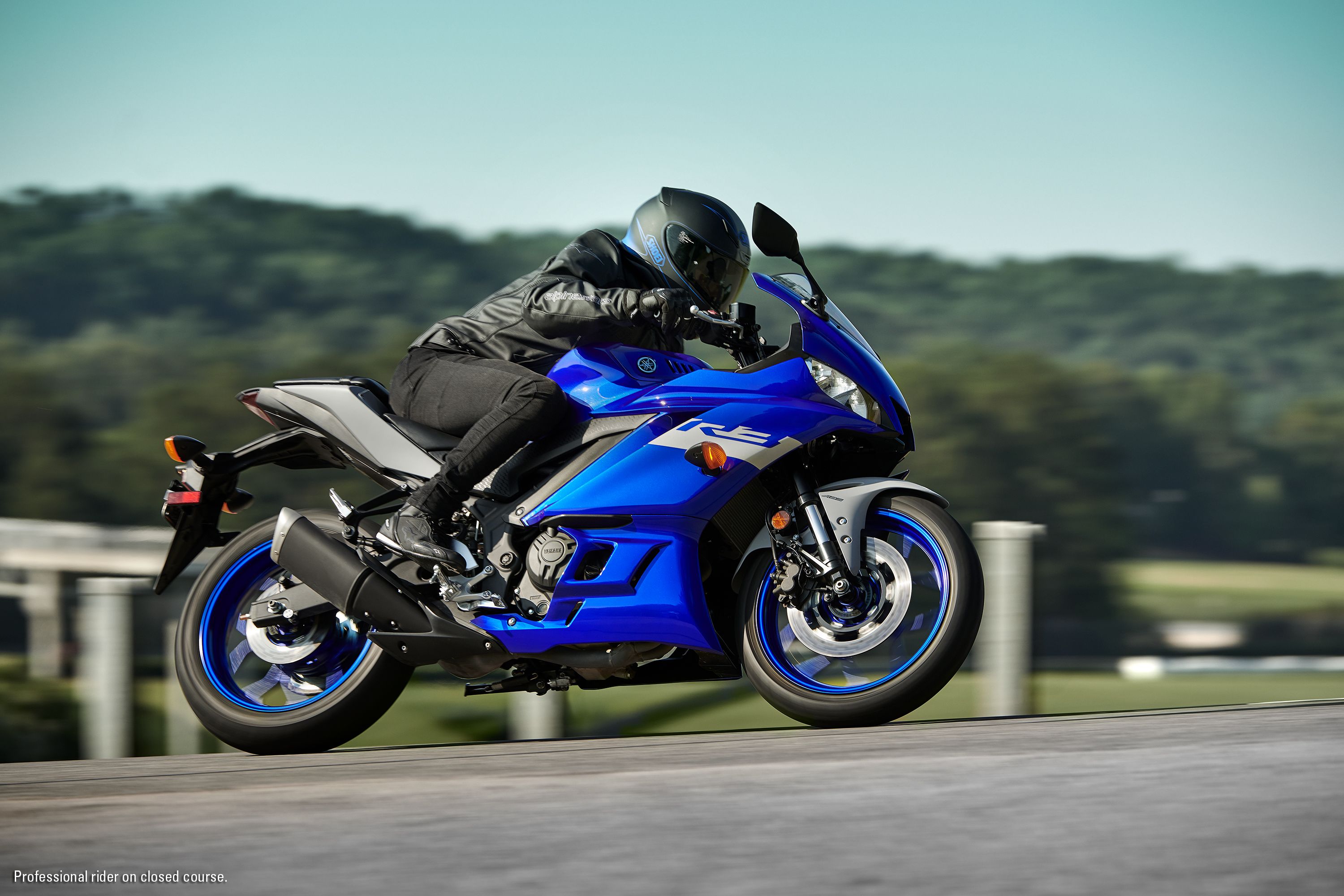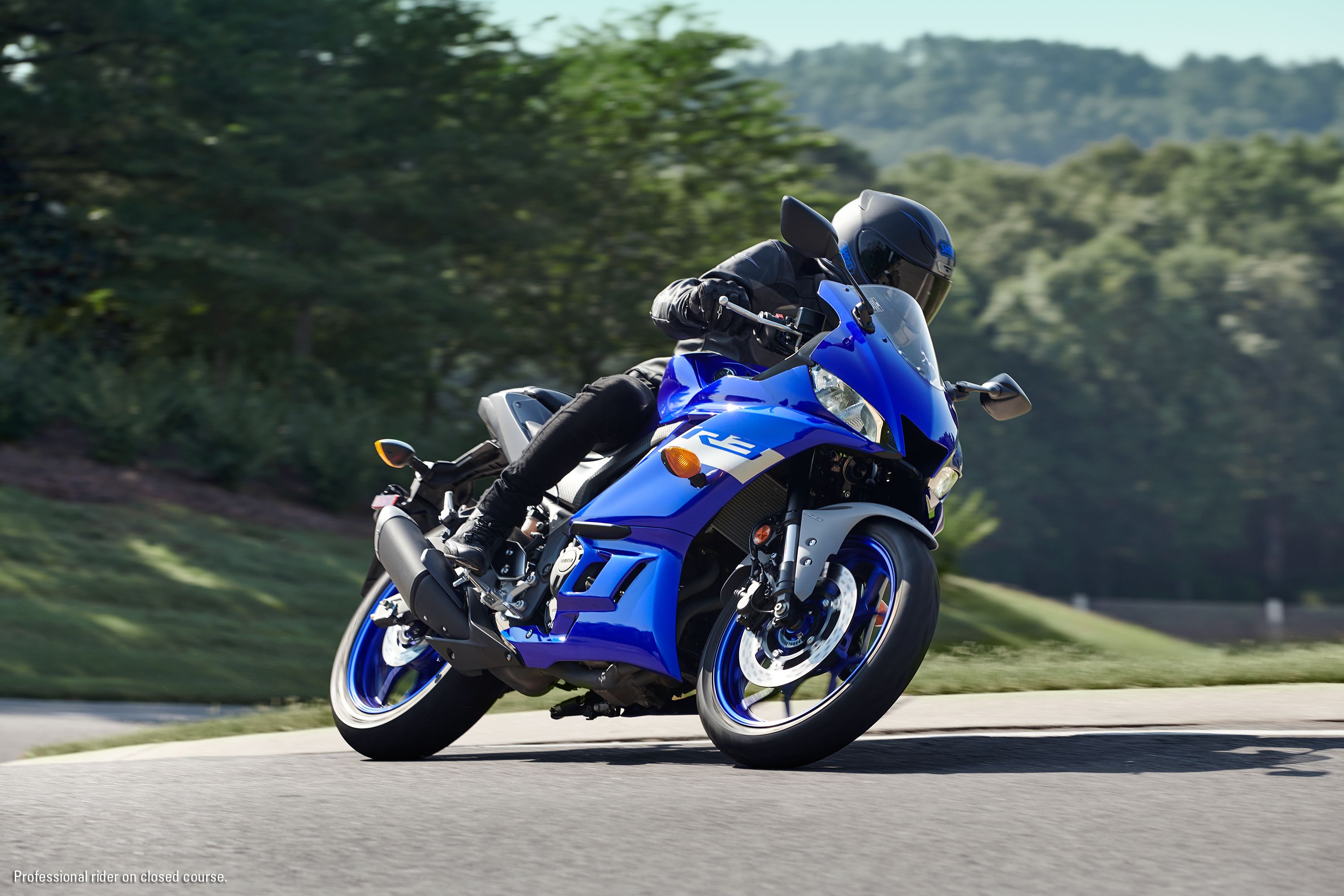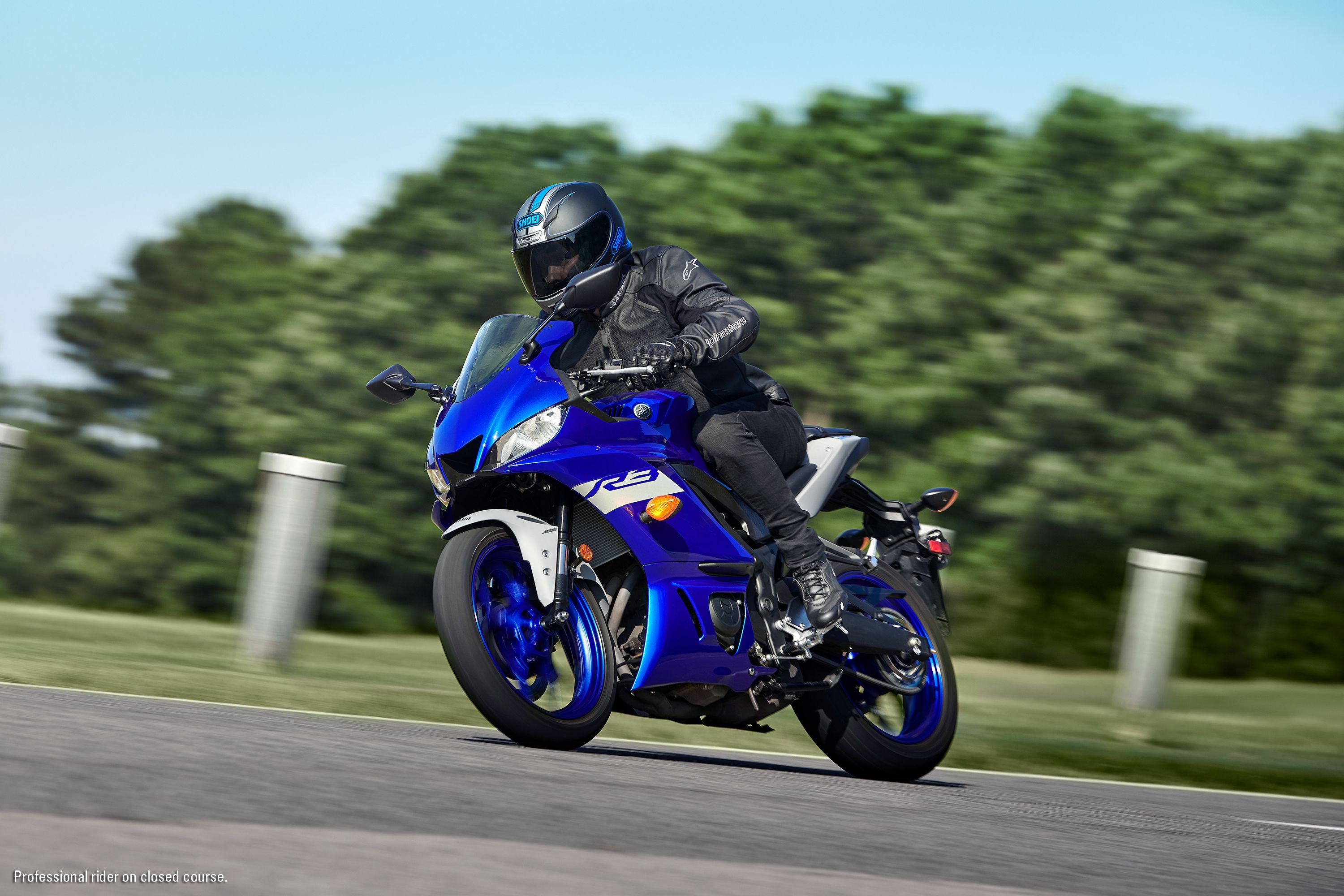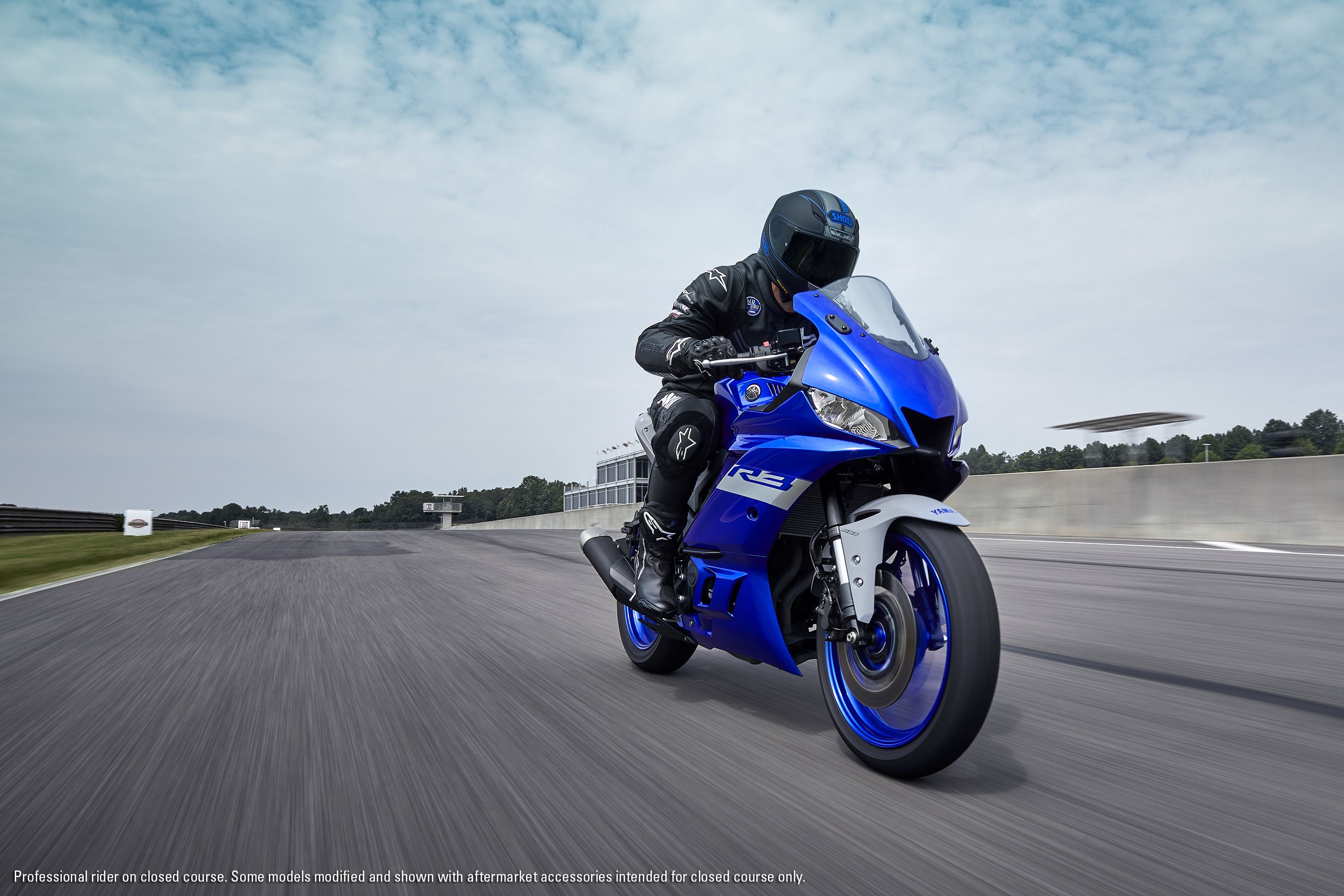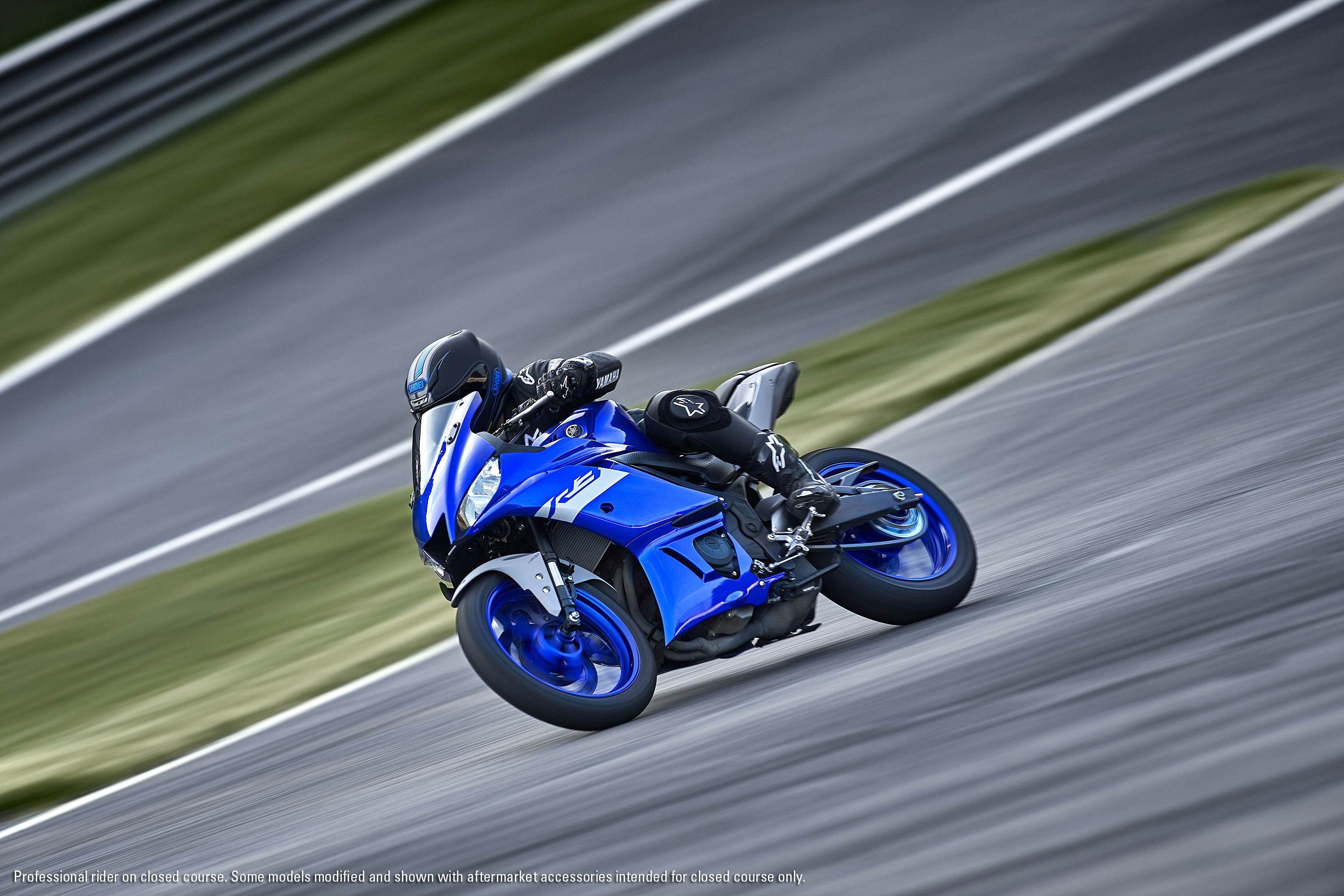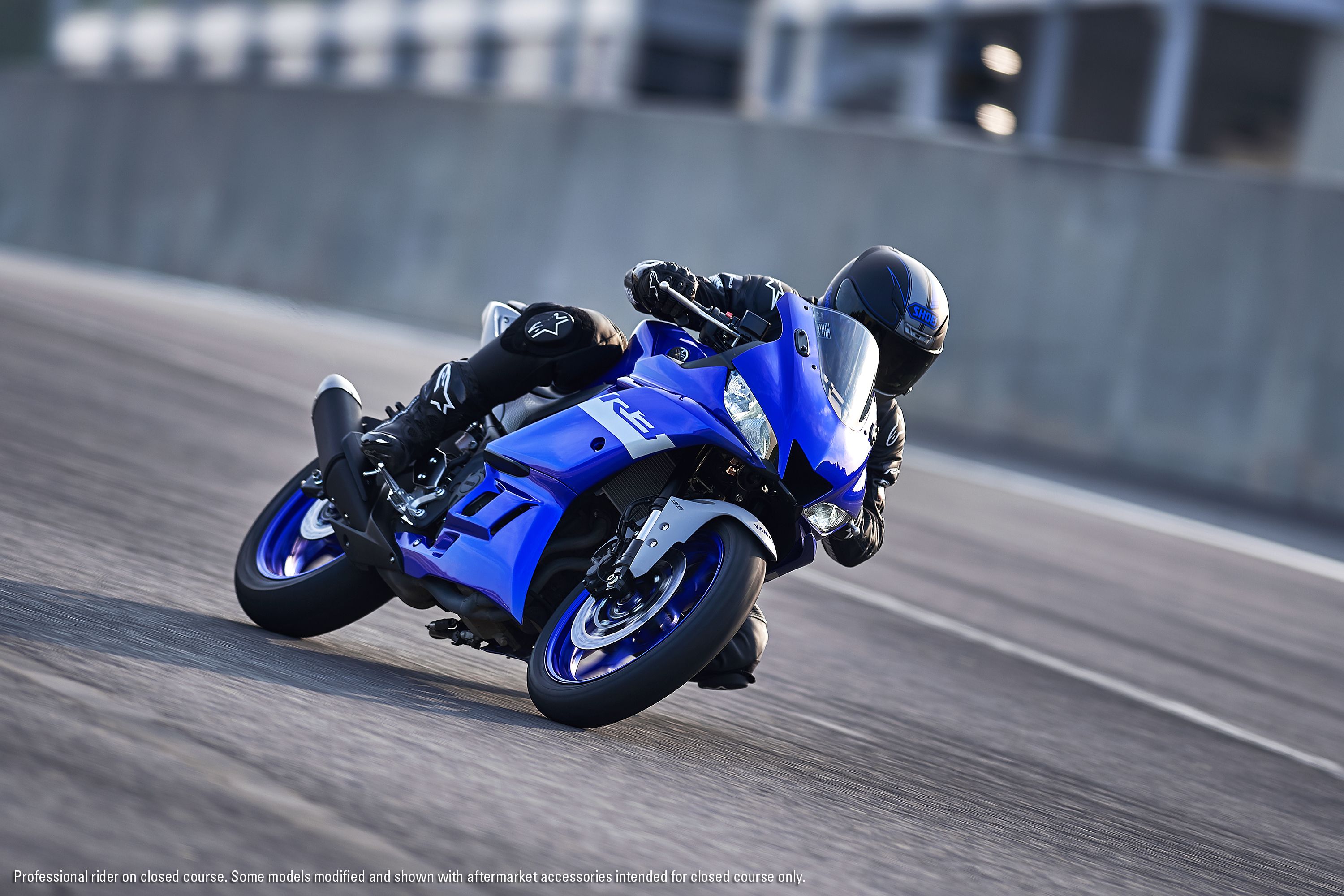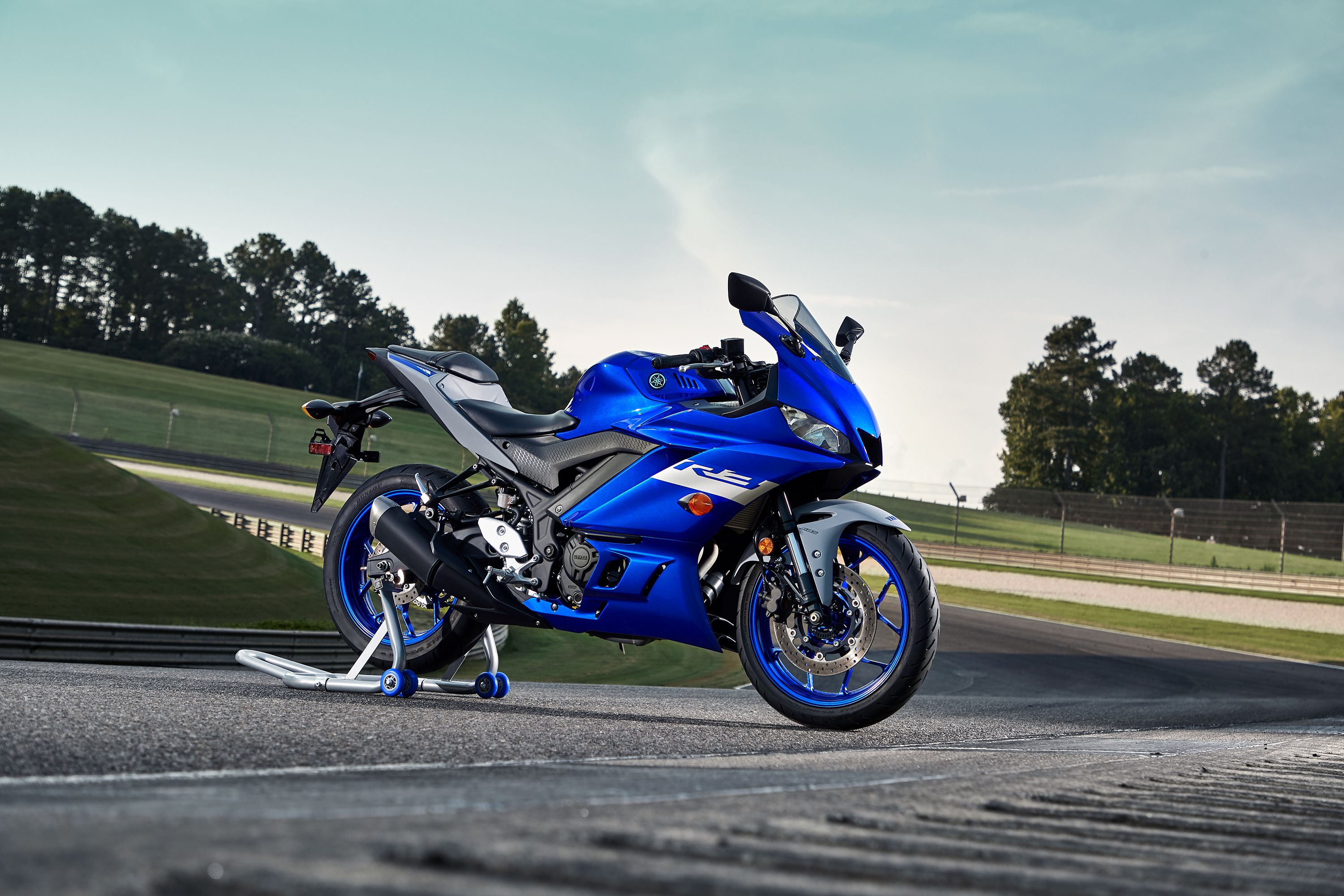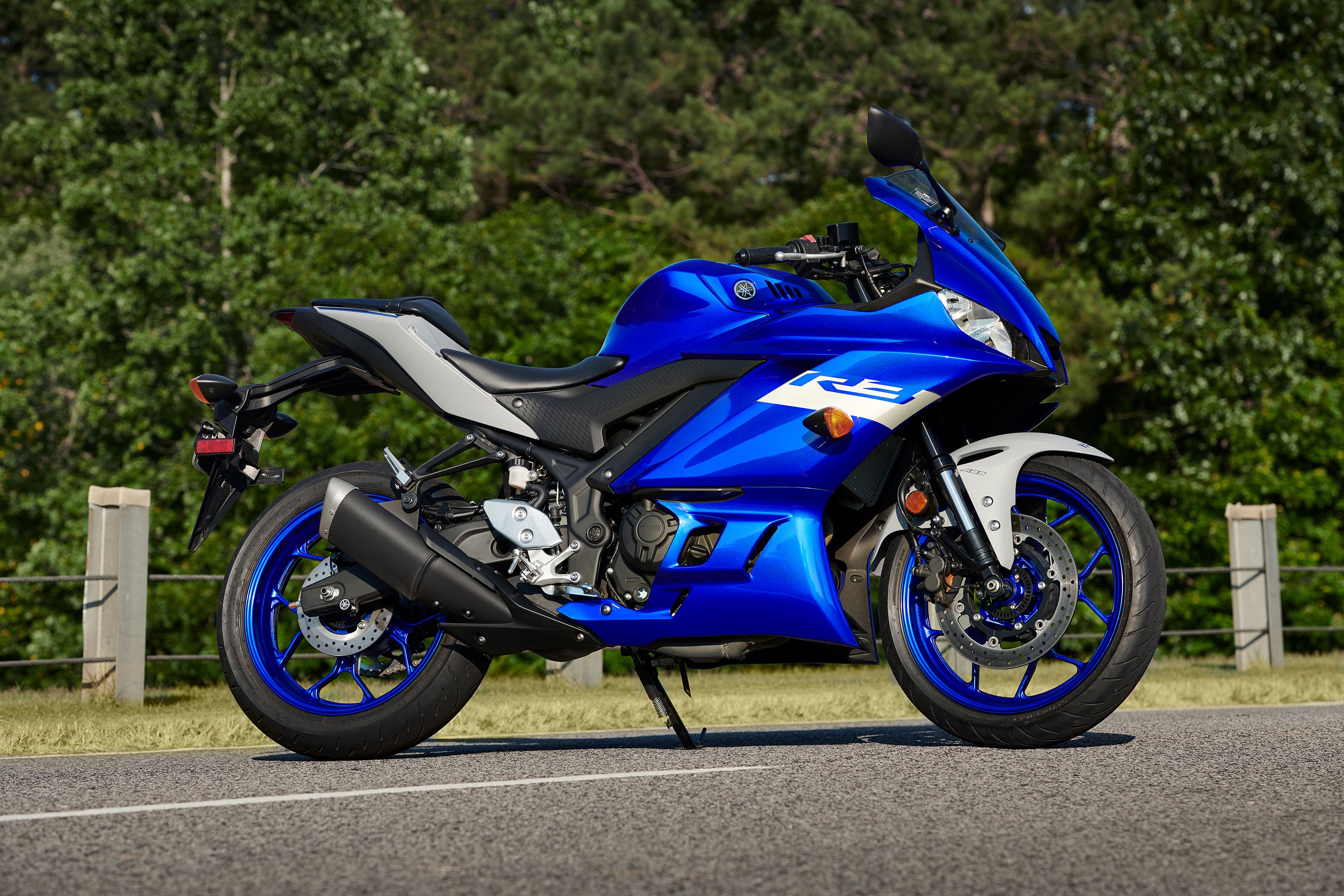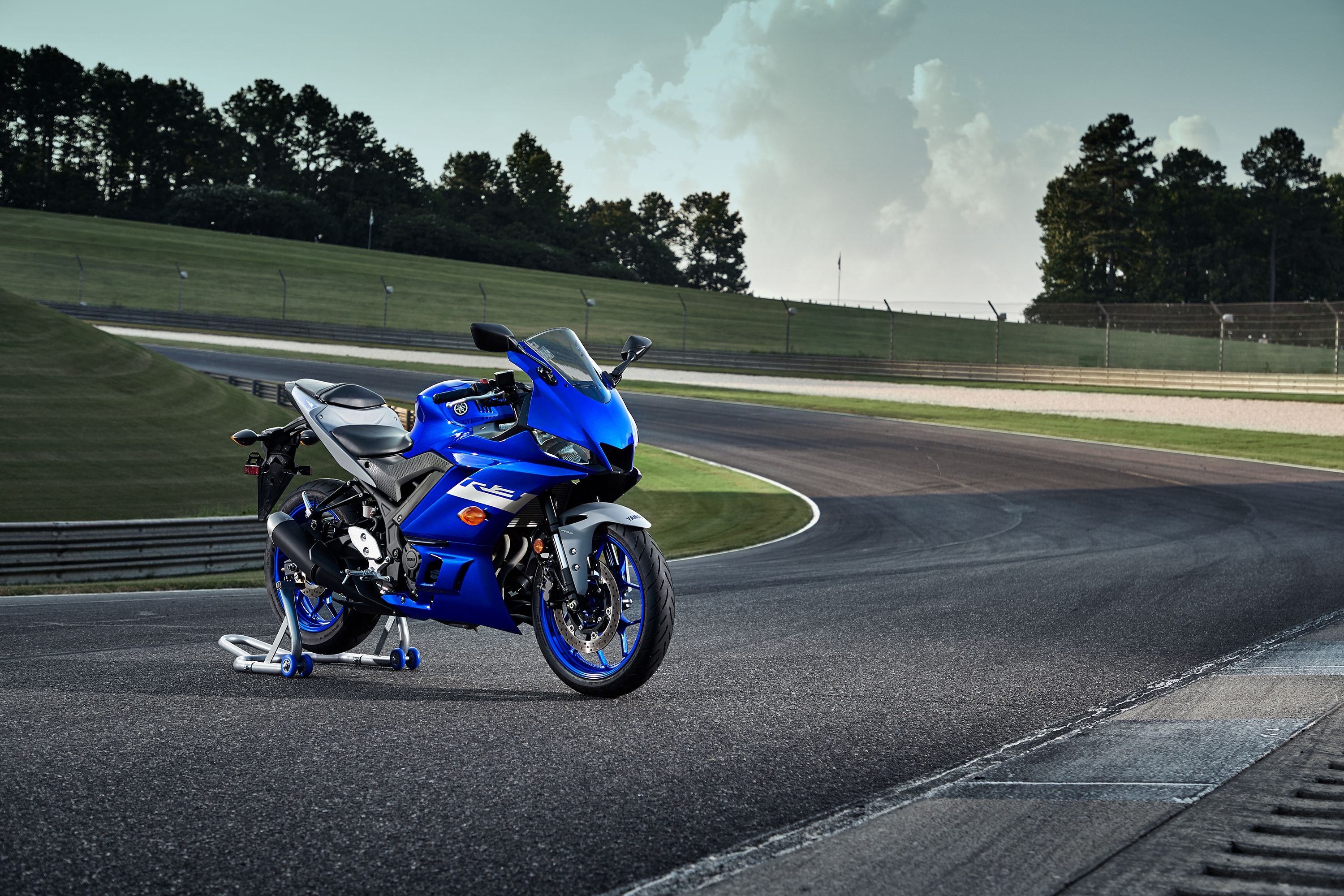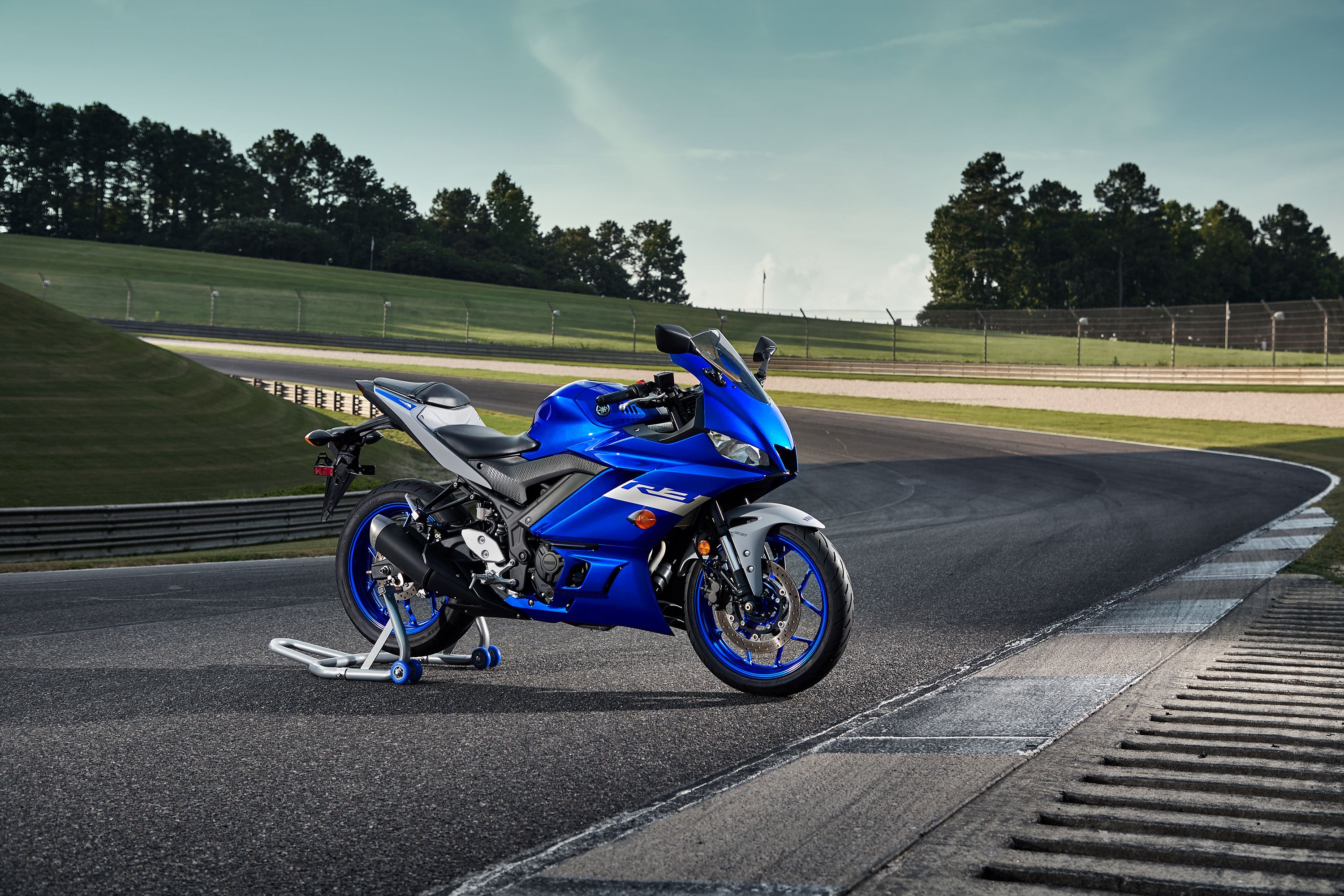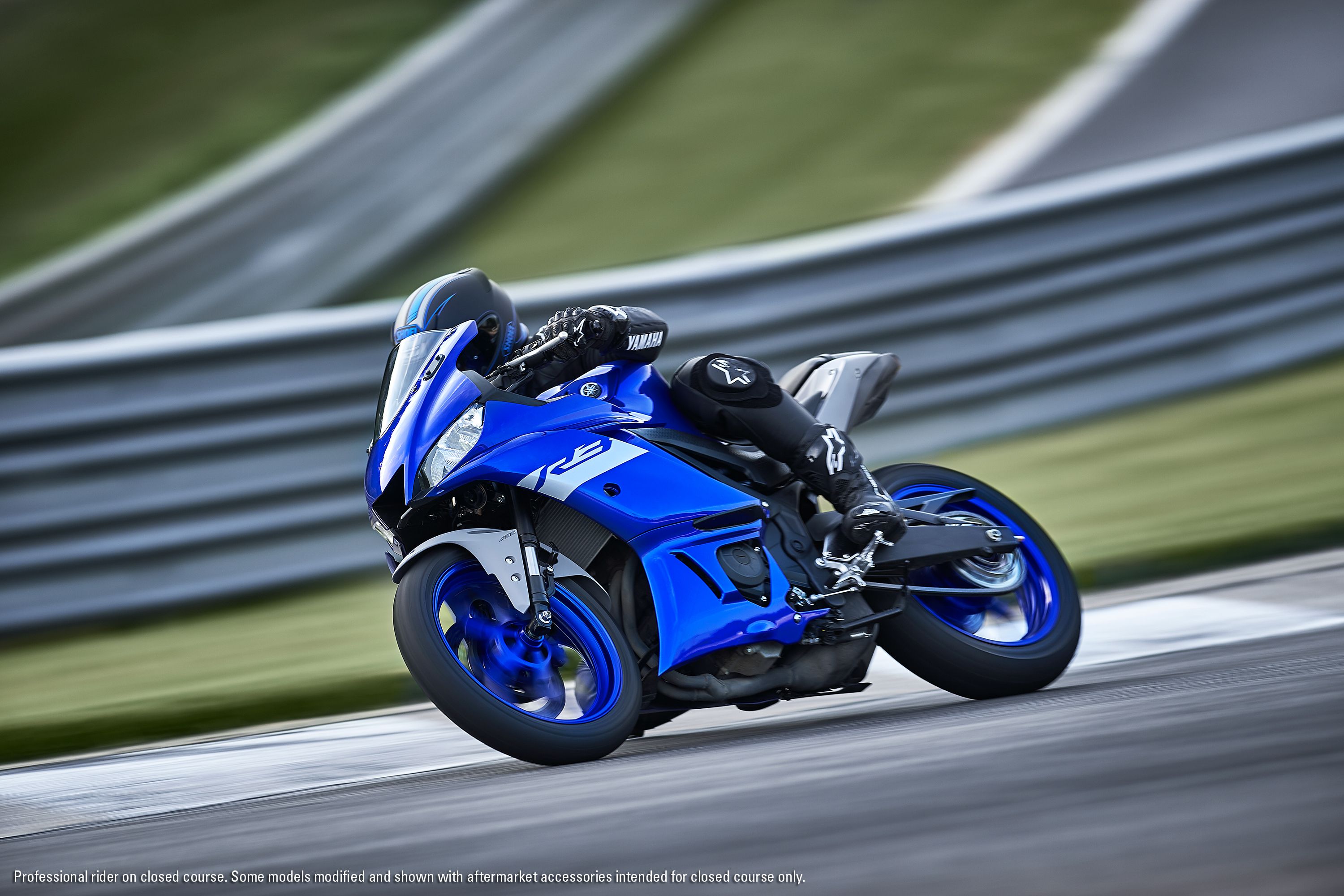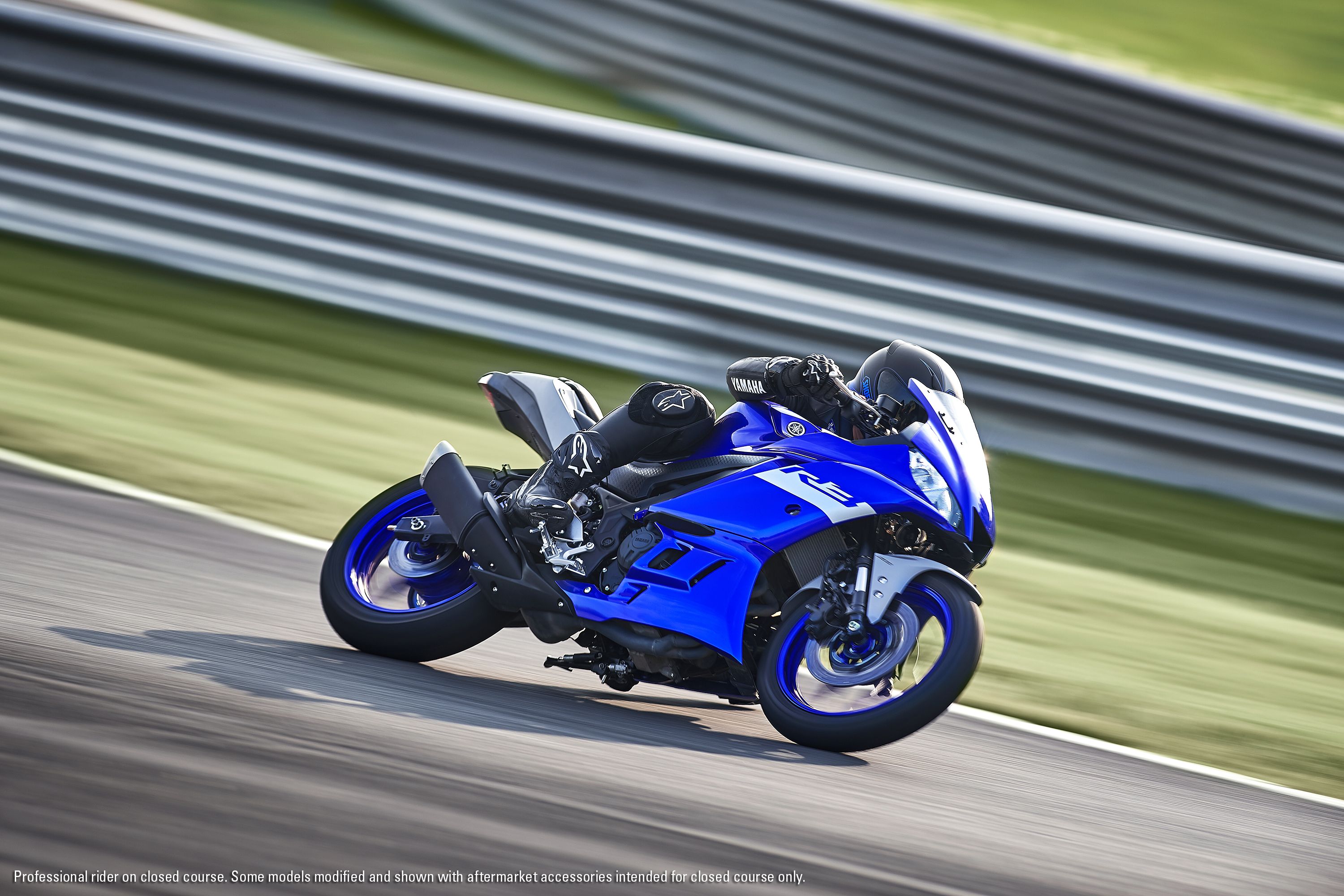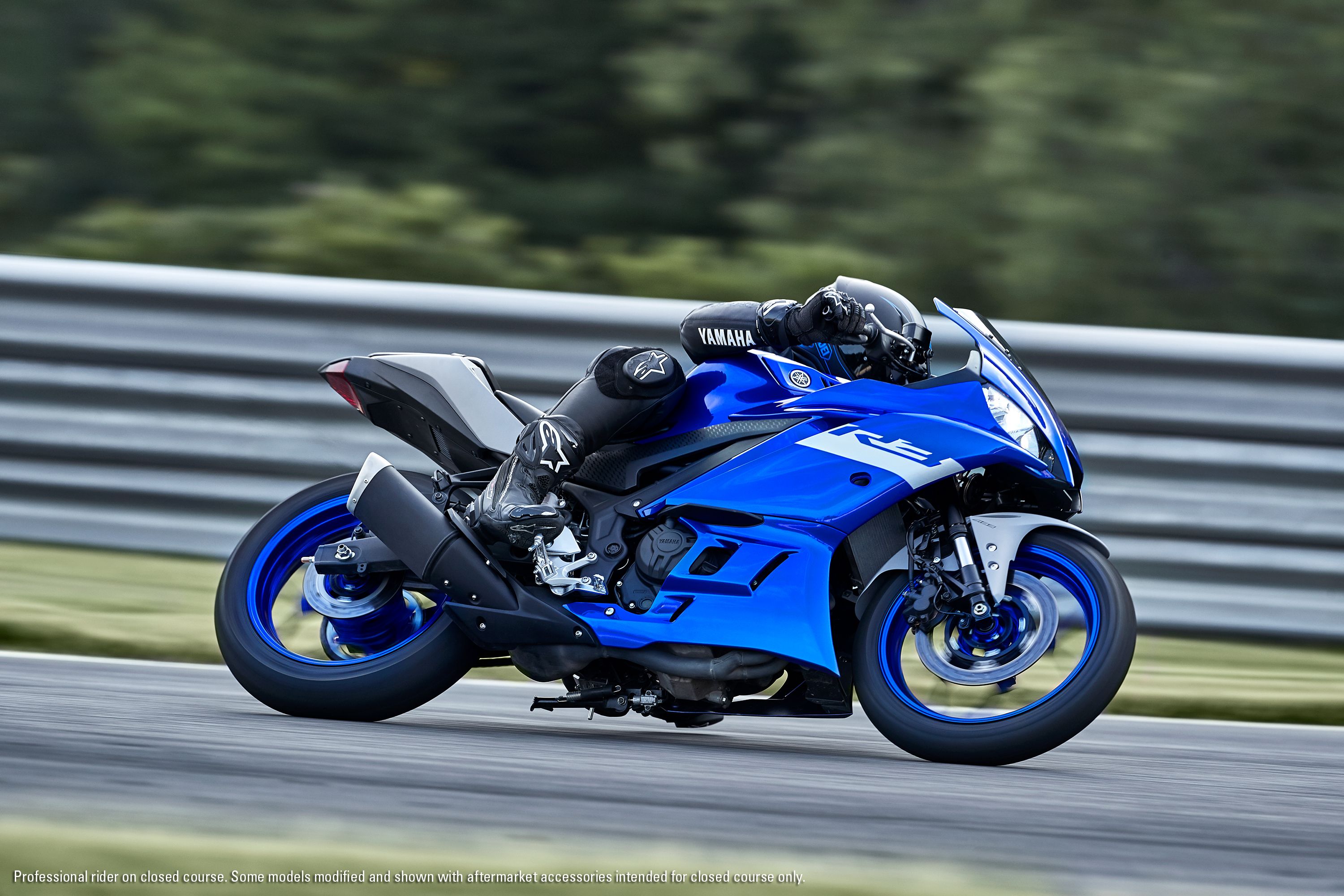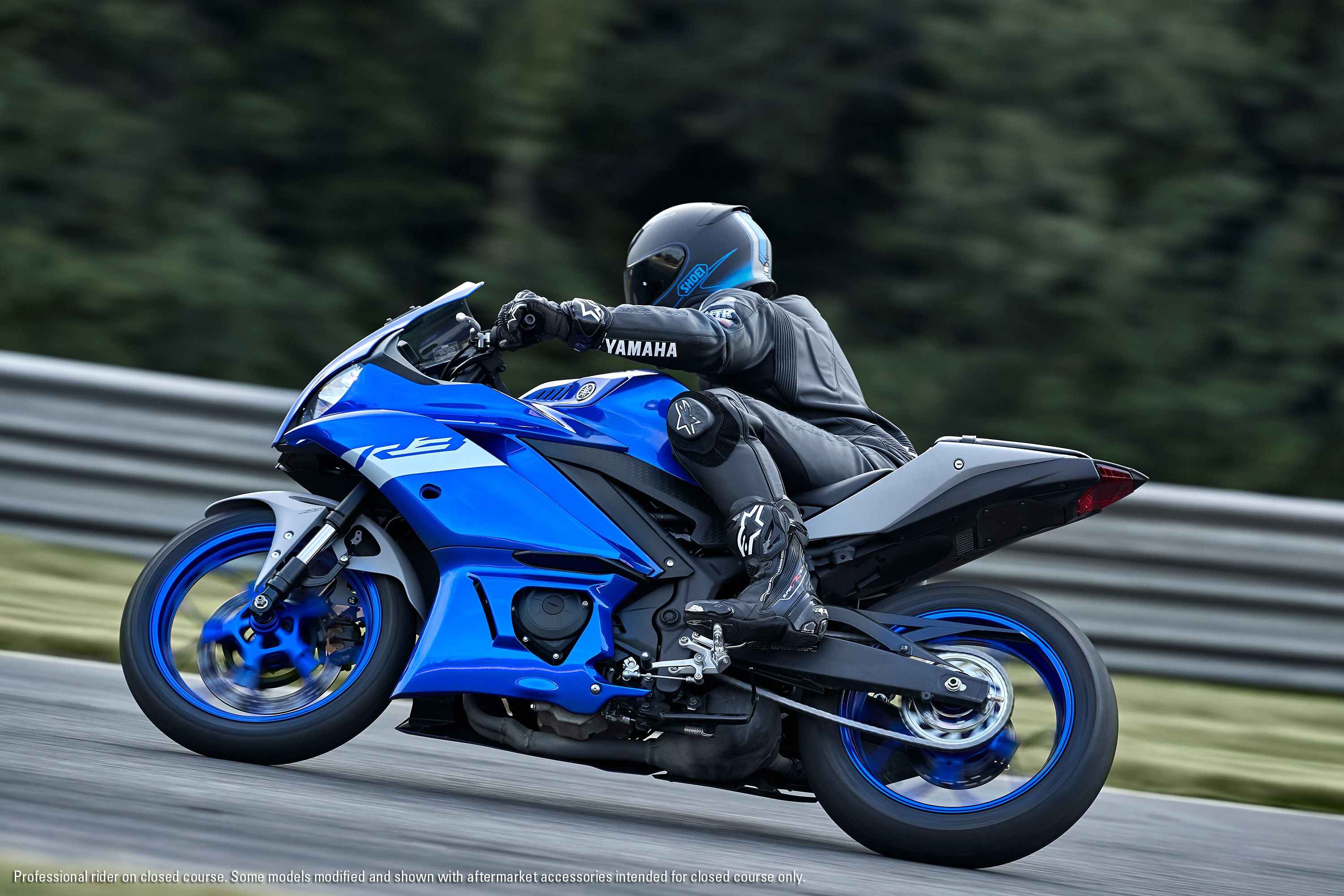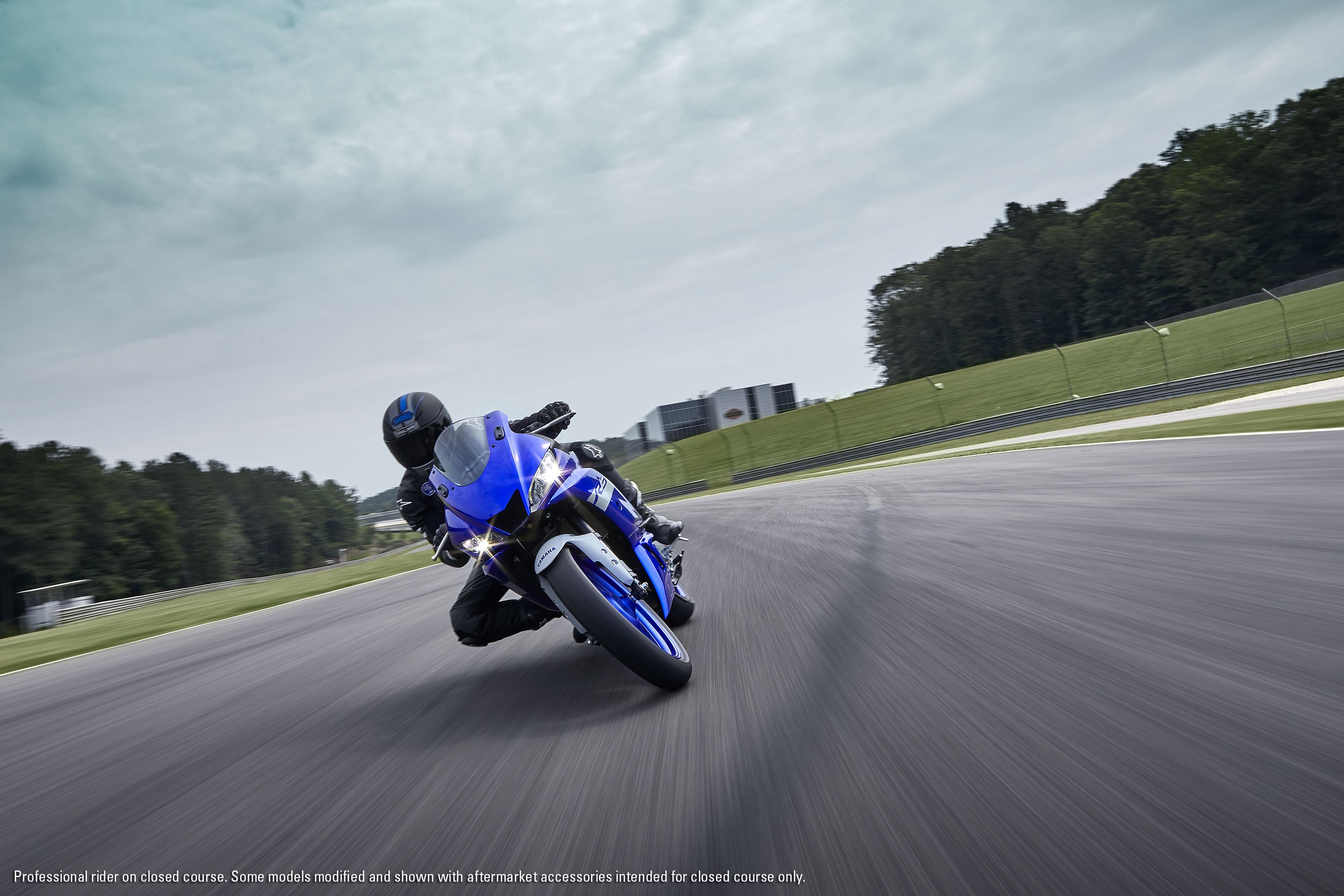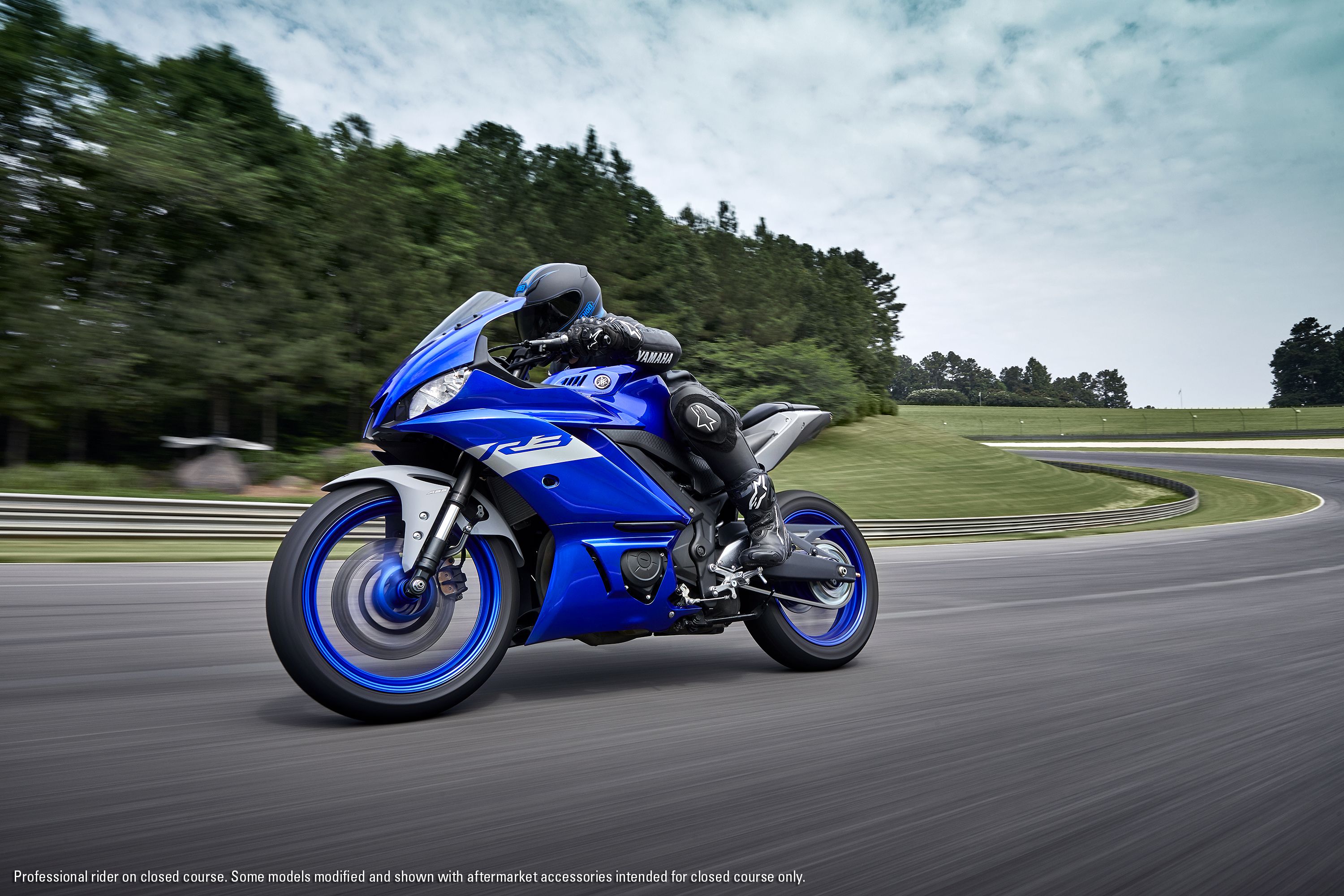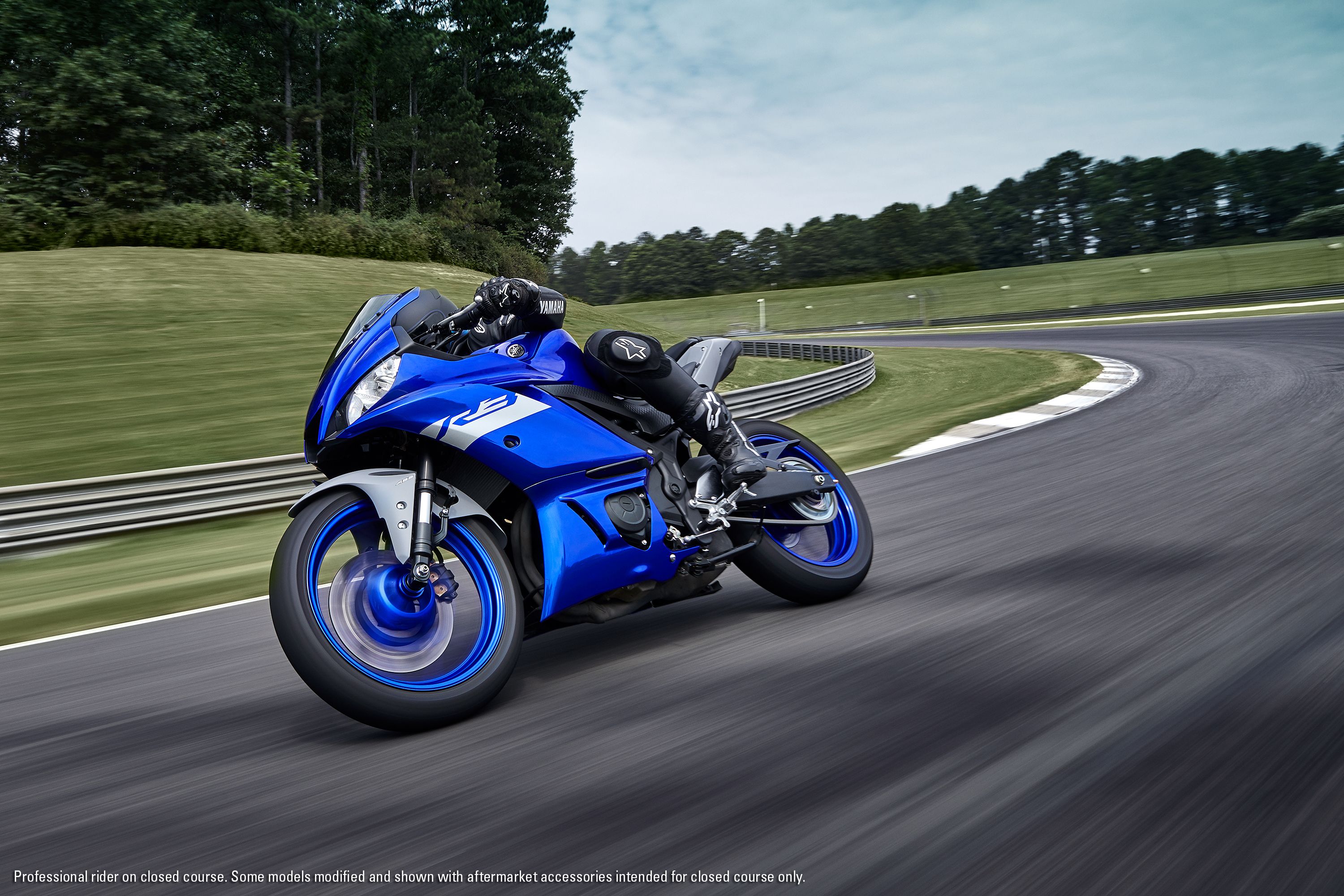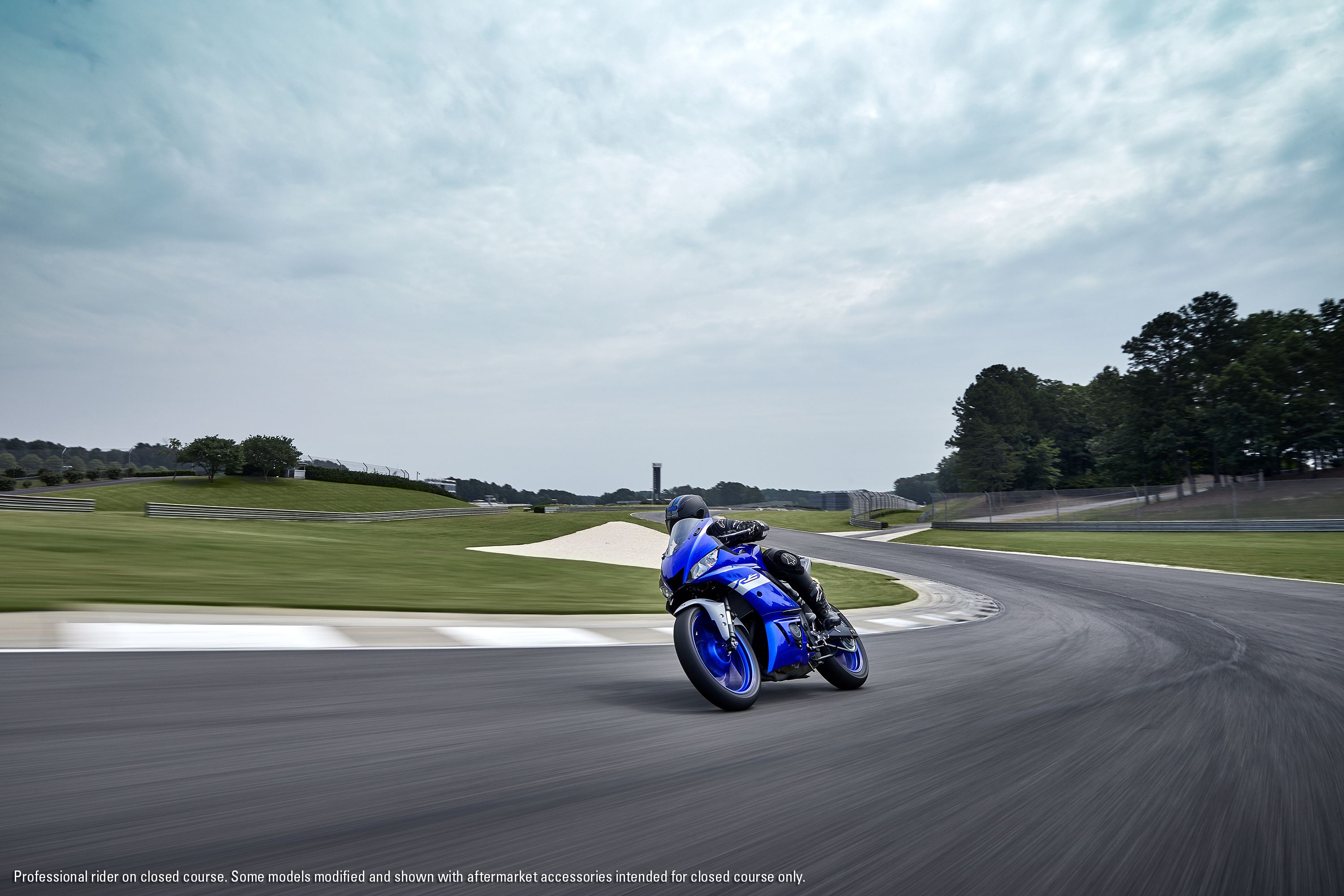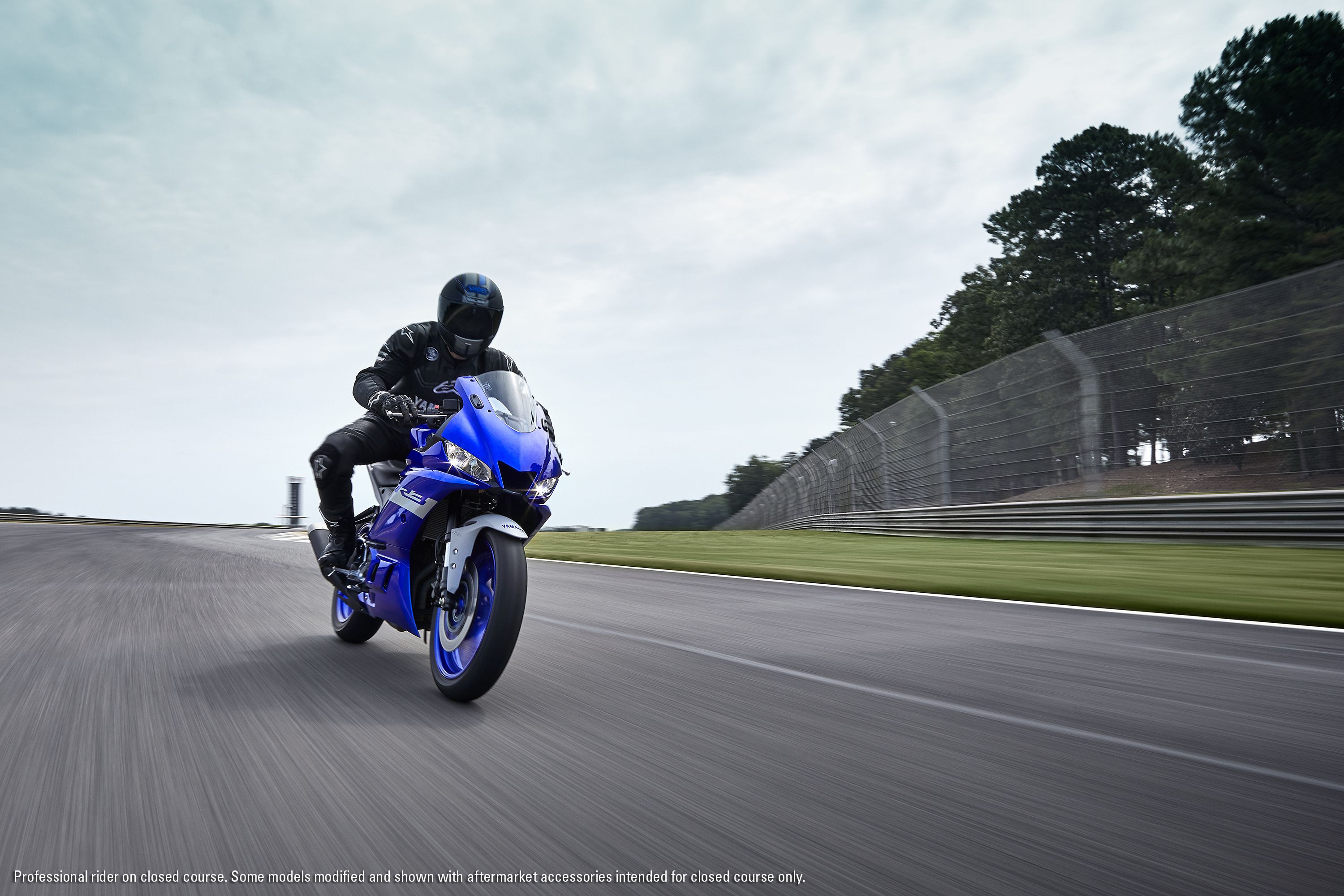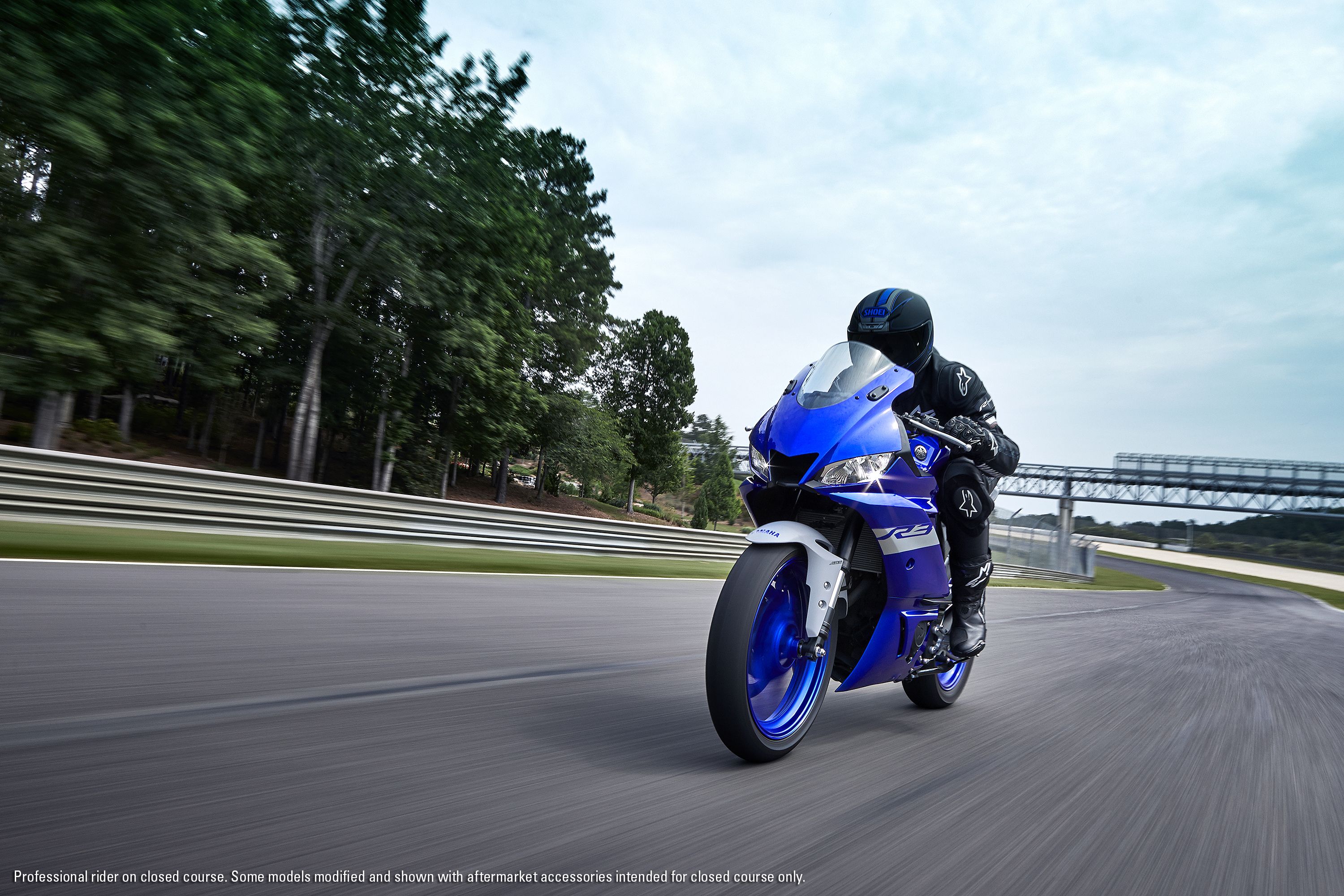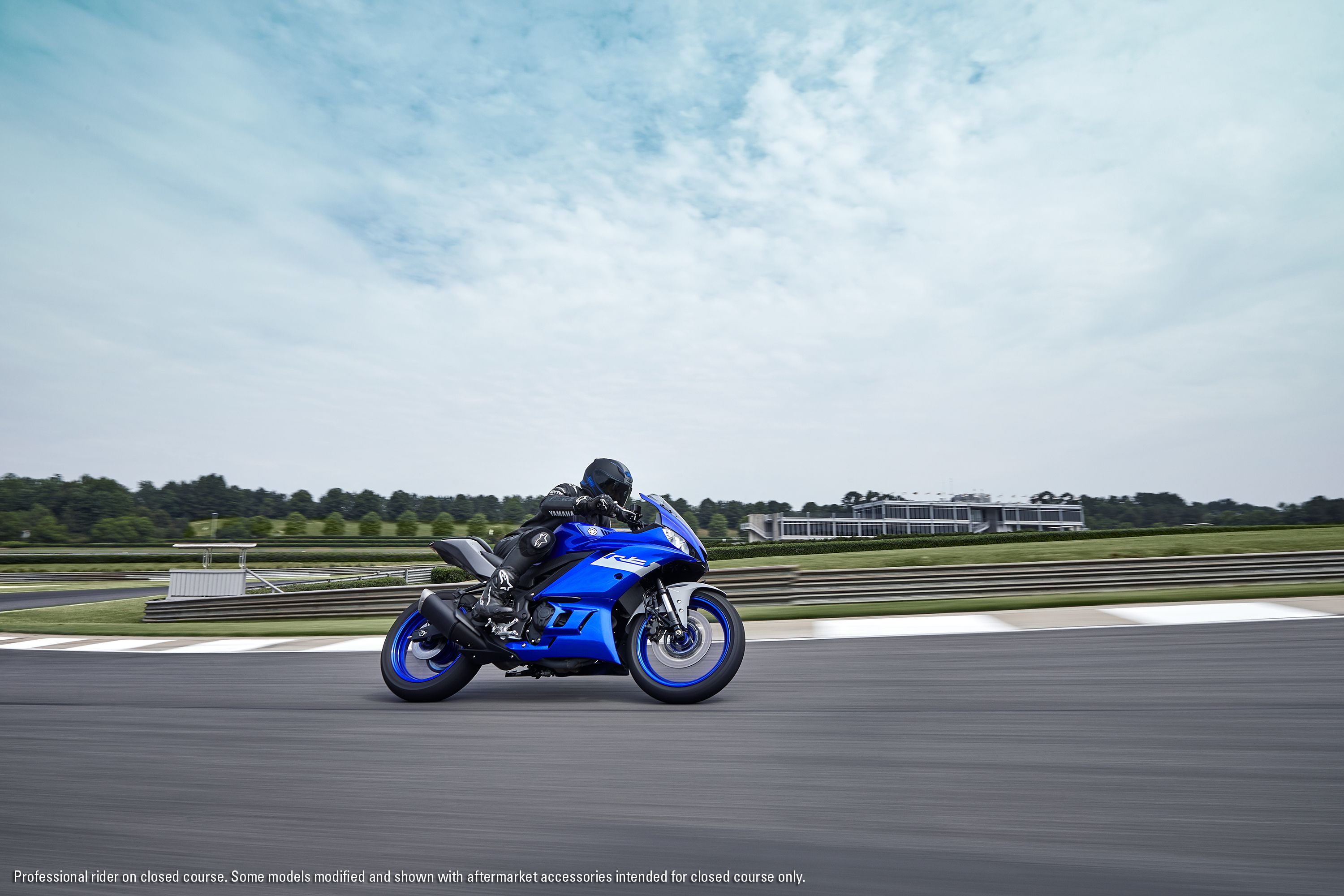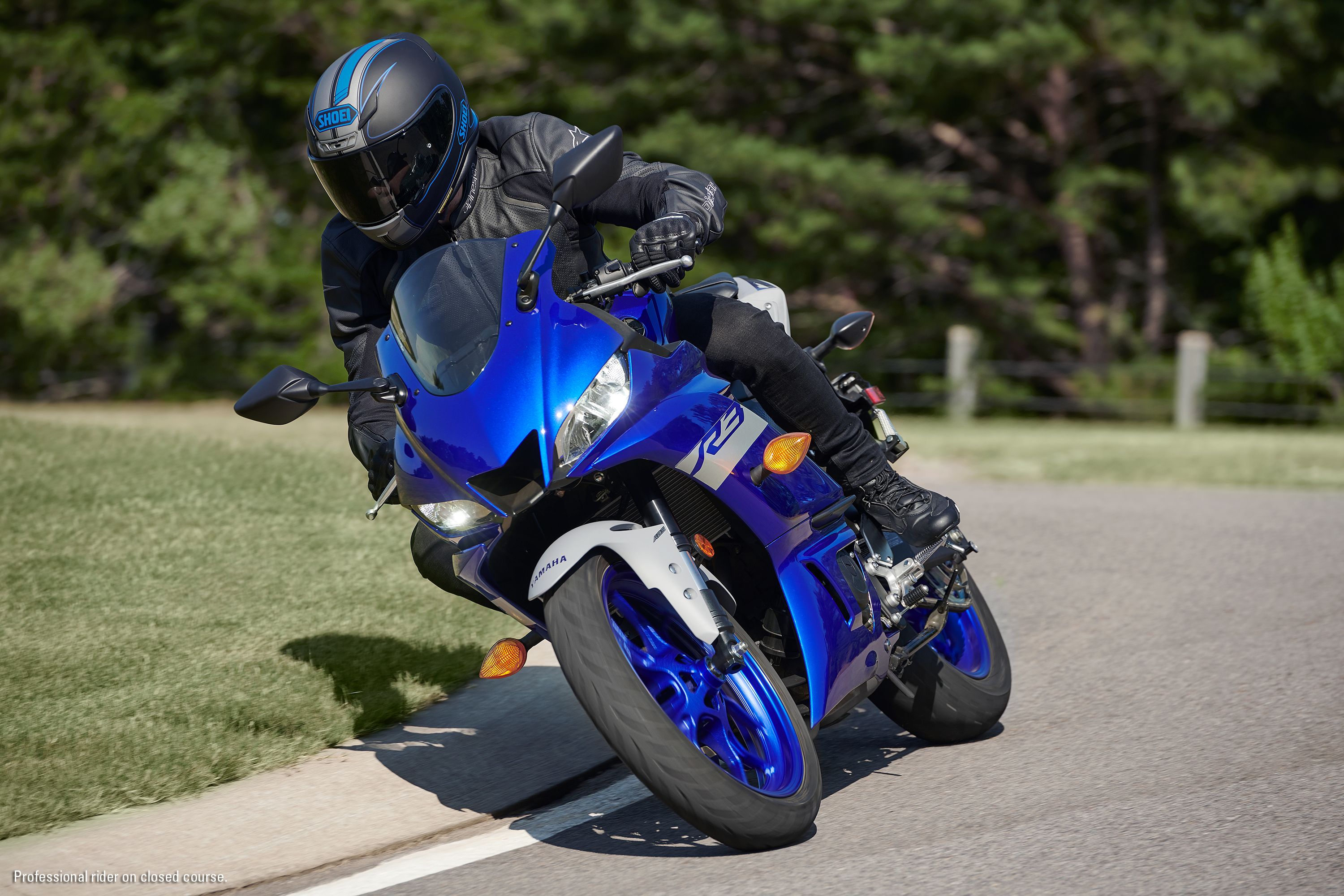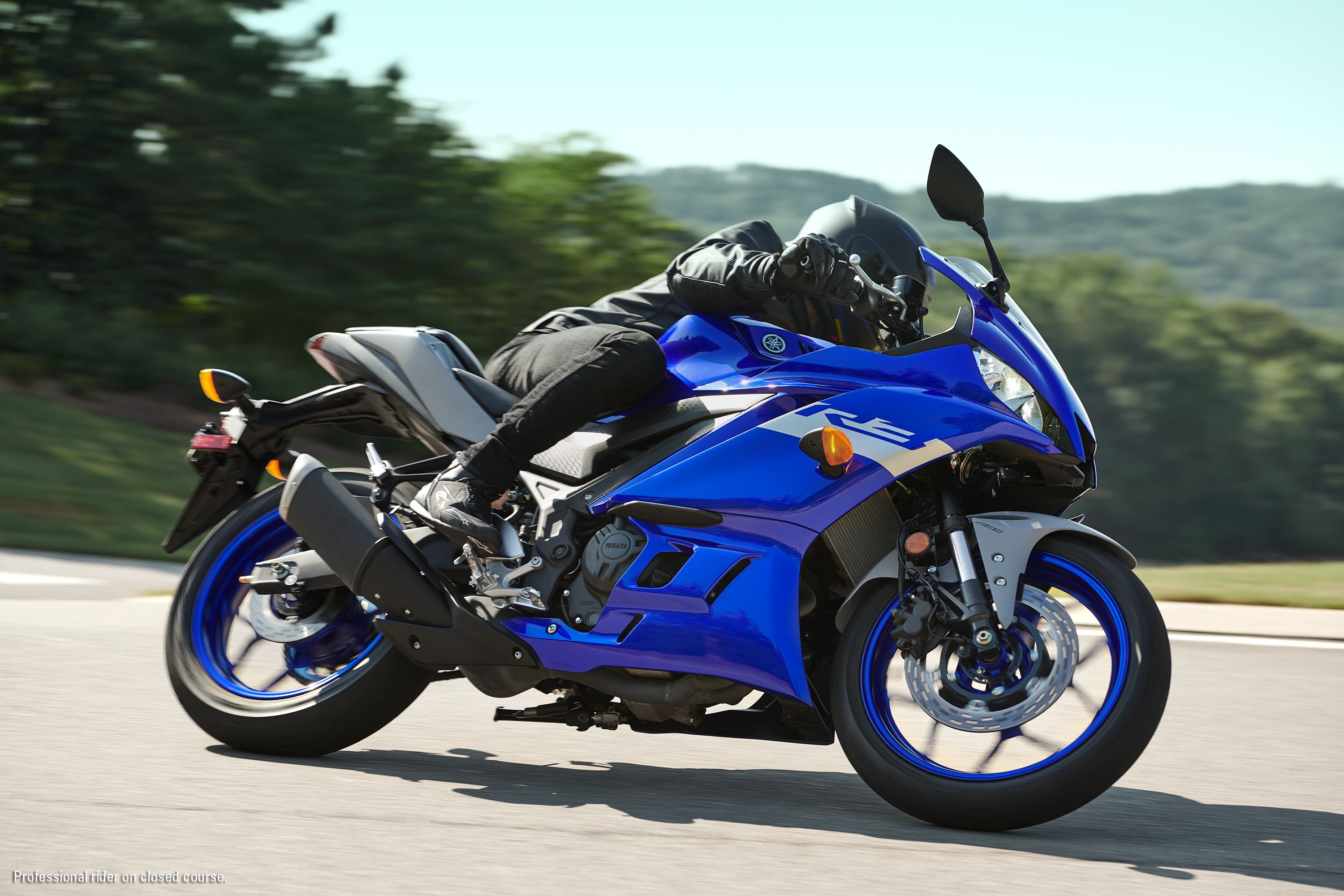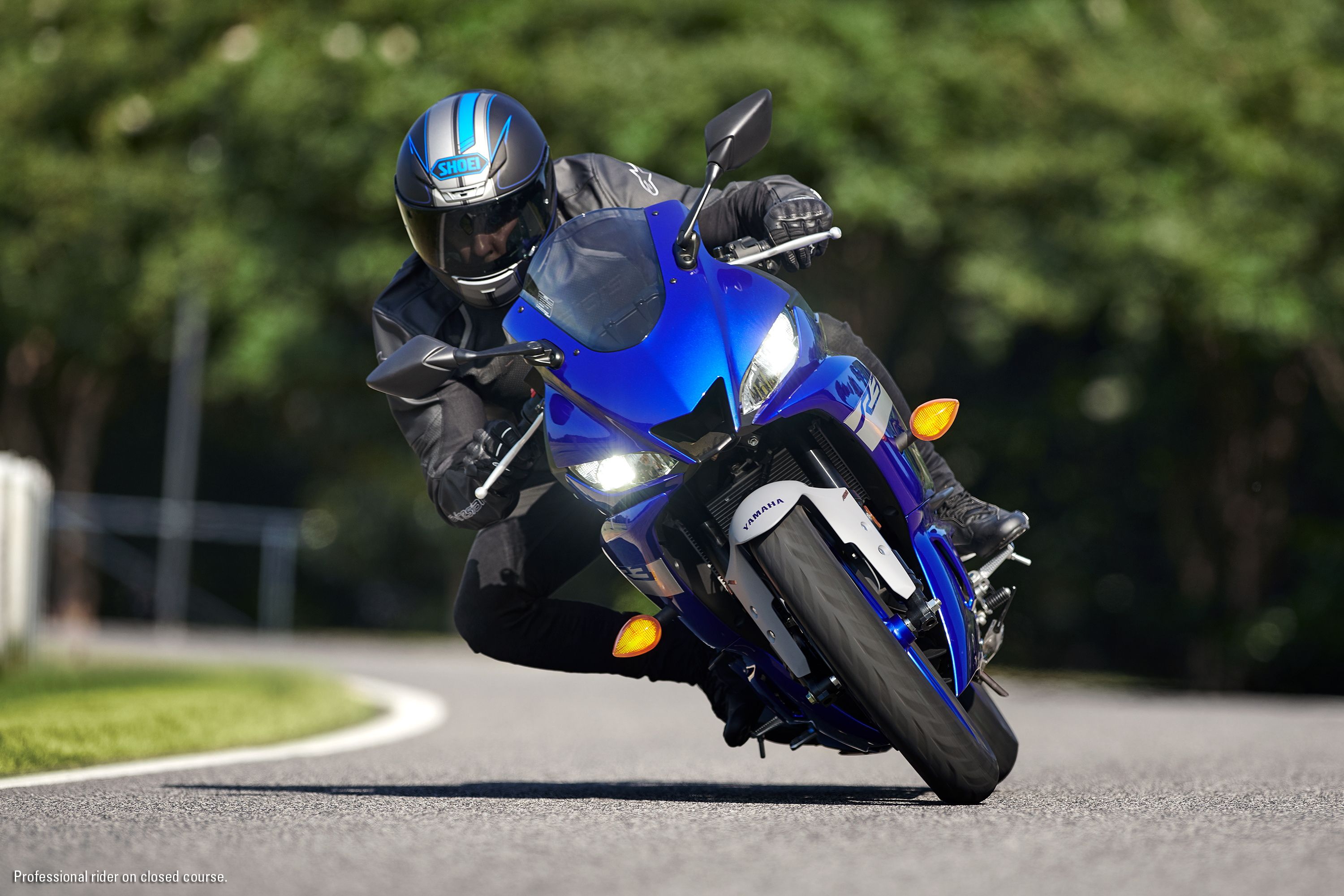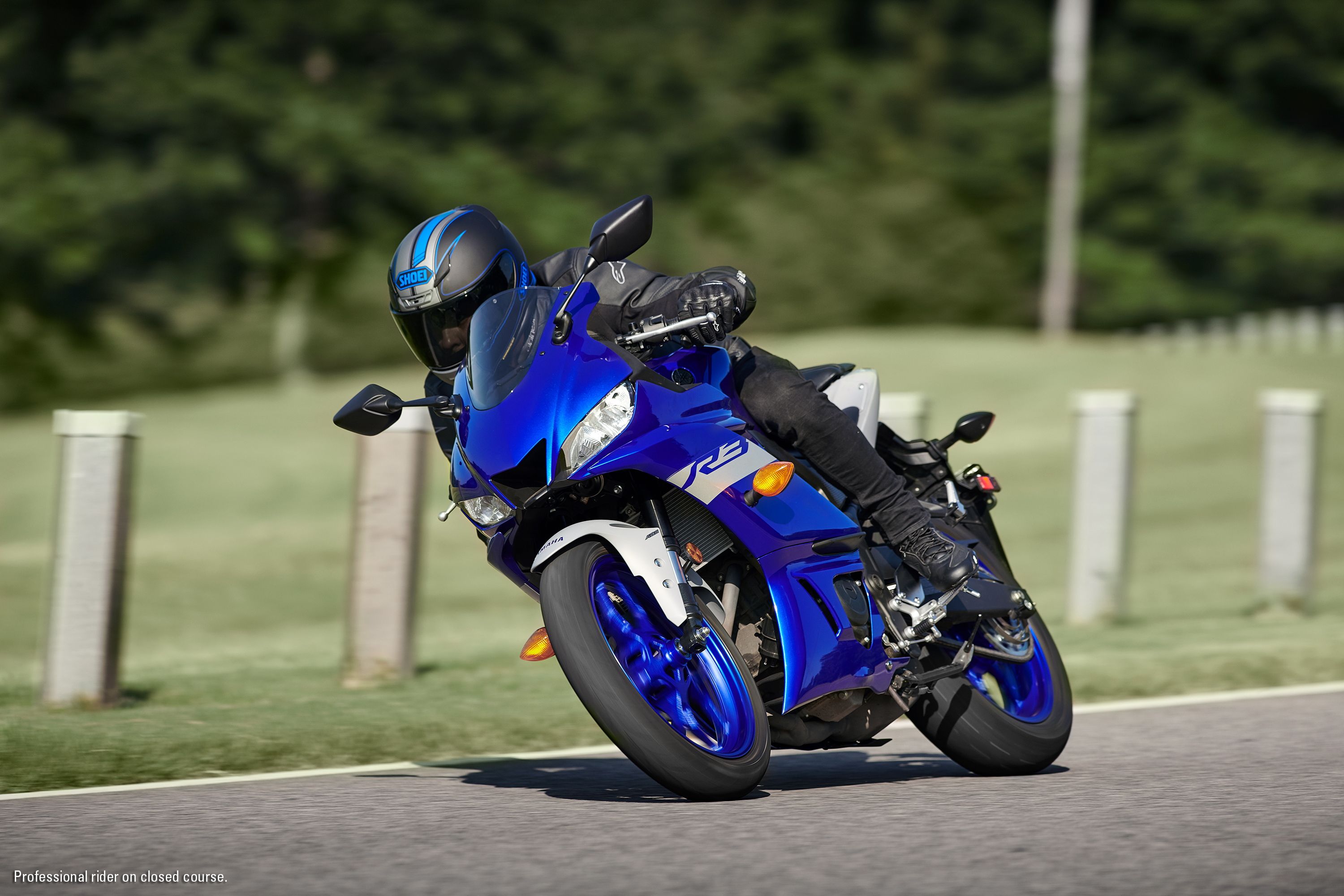Done properly, brand indoctrination starts early, and the updated-in-2019 YZF-R3 is Yamaha's primary bid for the supersport larvae it needs to support the rest of the range. The”R3” presents a race-tastic face to the world with design elements borrowed from its big brothers, the YZF-R6 and YZF-R1. It sports lower-drag bodywork and the same powerplant as the '18 model for a net performance gain, however slim, and maintains its agile nature/fun factor for experienced pilots.
2019 - 2022 Yamaha YZF-R3
- Make: Array
- Model: 2019 - 2022 Yamaha YZF-R3
- Engine/Motor: inline-2
- [do not use] Vehicle Model: Array
Yamaha YZF-R3 Design
As always, form follows function on the YZF-R3 with an overall design that is largely driven by racing considerations. The R3 gets the BNL treatment, and it's all about performance as the R3 takes on aspects of the track-proven YZR-M1.
A sleeker fairing leads the way with its customary intake cutout separating the new LED headlights below a newly-shaped bubble screen that forms a low-turbulence wind pocket, but you have to tuck in tightly -- race-style -- to benefit from it. The low-drag bodywork is designed to garner a claimed seven-percent better penetration and an extra five mph at the top-end. That's right folks, it's as lean as a snake with nothing of fat in evidence to slow it down.
The 3.7-gallon tank was reshaped to be both wider and lower at the top, and that works with the newly lowered handlebar position to pull the rider further into the bike the bike}} for a better rider/machine connection. Inverted forks beef up the front end a bit, but the waist is as slim as ever where tank, frame and saddle meet.
The seat is heavily beveled so as to not bite the thighs when you deploy your training wheels or when you're throwing the body-English around and caution to the wind. There's a steep rise to the pillion pad that forms an excellent butt-stop for the pilot and leaves your passenger with a lofted vantage point. Fold-up passenger footpegs hang off the subframe, but other than a grab-strap of questionable strength, there's nothing for your human cargo to hold onto besides yourself.
A bright LED taillight forms the tip of the tail, as it were, with license plate and rear directional lights mounted on a short mudguard to finish out the gear-in-the-rear. Short bars pull the rider forward into the Superman position, reinforced by the jockey-mount footpegs that tuck the heels in and make for easy body mechanics. It's more properly a race-trainer than anything else at the end of the day.
Yamaha YZF-R3 Chassis
Steel members on the YZF-R3 are welded to form the main structure and subframe with the engine used as a stressed member to displace the downtube/cradle section of the frame and save some weight. Seems like it paid off. The bike weighs in at a low 375-pounds soaking wet with a roughly 50-50 split between axles.
Inverted forks replace the standard stems from 2018, and that sees a freshly redesigned tripleclamp that sets the rake angle at 25-degrees with 3.7-inches of trail for a very eager nature in the corners though the steering will only sweep through 16-degrees per side, and that last will make itself felt when trying to navigate the parking lot.
The asymmetrical swingarm articulates the rear wheel with a KYB monoshock that delivers variable preload as the only suspension tweak on the whole bike. Suspension is on par with 4.9-inches of travel out back and 5.1-inches up front. A pair of 17-inch wheels bring a sense of symmetry back to the picture with a cast-aluminum structure that contributes to keeping unsprung weight low and the suspension as responsive as possible. New Dunlop Sportmax GPR-300 hoops round out the rolling chassis and provide grippy performance from knee-drag on one side to knee-drag on the other.
Braking duties fall to a 298 mm disc and twin-piston caliper up front and the single-pot anchor and 220 mm rear disc and ABS is the only ticket now with a non-ABS model not offered anymore.
|
Suspension, Front: |
Inverted telescopic fork; 5.1-in travel |
|
Suspension, Rear: |
Monocross single shock, adjustable preload; 4.9-in travel |
|
Rake (Caster Angle): |
25.0° |
|
Trail: |
3.7 in |
|
Brakes, Front: |
298 mm hydraulic disc; ABS |
|
Brakes, Rear: |
220 mm hydraulic disc; ABS |
|
Tire, Front: |
110/70-17 Dunlop® Sportmax® GPR-300 |
|
Tire, Rear: |
140/70-17 Dunlop® Sportmax® GPR-300 |
Yamaha YZF-R3 Drivetrain
Yamaha's 321 cc parallel-twin engine reprises its role as the driving force behind the YZF-R3. It rocks a 180-degree firing order with a counterbalancer that takes the hand-stinging edge off the vibrations, and dual over-head cams that time the eight-valve head. The short-stroke engine is laid out with a pair of 68 mm bores with a 44.1 mm stroke and an 11.2-to-1 compression ratio that will put you at the expensive pump every time.
There's an offset to the cylinders that reduces piston-to-cylinder friction and allow for quicker revs, and that's a good thing 'cause this mill likes its revs. Power peaks at 10,750 rpm with 21.8-pounds o' grunt that top out at 9-grand. A standard, non-slipper clutch couples engine power to the six-speed transmission, and while I would have liked to see an anti-hop clutch here, it's fitting that it doesn't run one. The kids gotta' learn sometime.
Transistor ignition and electronic fuel injection make up the fanciest parts of the engine management system, so if you're looking for rider modes, traction control, and anti-wheelie features, you're looking in the wrong place. A tough chain-style final drive carries the power to the rear wheel, and if you have the stones for it, you can milk a top speed in the neighborhood of 117 mph out of this machine. Fair warning, she comes geared for the top end and will feel a trifle sluggish coming out of the hole.
|
Engine: |
321 cc liquid-cooled, DOHC inline twin-cylinder; 8 valves |
|
Bore x Stroke: |
68.0 mm x 44.1 mm |
|
Compression Ratio: |
11.2:1 |
|
Fuel Delivery: |
Fuel Injection |
|
Ignition: |
TCI: Transistor Controlled Ignition |
|
Transmission: |
6-speed; multiplate clutch |
Yamaha YZF-R3 Pricing
MSRP on the 2022 YZF-R3 is the same as last year at $5.299k. Yamaha covers your new YZF-R3 with a one-year limited warranty.
|
Warranty: |
1 Year (Limited Factory Warranty) |
|
Color: |
|
|
└ 2019: |
non-ABS: Matte Black, Team Yamaha Blue ; ABS: Matte Black, Vivid White |
|
└ 2020: |
non ABS: Team Yamaha Blue; ABS: Team Yamaha Blue, Matte Silver, Matte Black |
|
└ 2021: |
Team Yamaha Blue, Matte Stealth Black, Electric Teal Blue |
|
└ 2022: |
Team Yamaha Blue, Midnight Black |
|
Price: |
|
|
└ 2020: |
non-ABS: $4,999, ABS: $5,299 |
|
└ 2021, 2022: |
$5,299 |
Yamaha YZF-R3 Competitors
There has been quite a race to the bottom within the sport-bike sector as of late, and all the big boys have their main players in place. It's a fair-enough bet that anyone looking at any one of the Big Four might find something interesting from one of its domestic competitors, so with that in mind, I grabbed the CBR300R for my head-to-head.
Honda CBR300R
Both bikes favor that supersport style that sees near-complete coverage by windtunnel-tested body panels and rock a nose-down/tail-up look that gives it that racer's stance that so many find appealing, even if they have no desire to ever actually hit a closed-circuit. Honda's own racing-team DNA plays a role in the overall CBR design, and unsurprisingly, it runs with lines and proportions that are very similar to the Yammy. The CBRs of today have lost that chunky Honda-ness that defined earlier generations in favor of this bold new look (wink, nudge) that carries itself with grace and dignity.
Honda leaves a few cubes on the table and runs a 286 cc mill against the Yammy's 321 cc, and that has the expected effect on the power numbers. The Red Rider's thumper claims 22 horses and 13 pounds o' torque for numbers that are well short of the YZF's 41/21.8. Top ends see a similar offset with Honda's approximate top speed at a claimed 90 mph. Sure, it's faster than you can legally use, but if the traffic is moving at 80-to-85 mph, it'll be nice to have a little bit more meat on the bone like what the Yamaha brings to the table.
If Honda pulls out a clear win, it's at the checkout counter. The non-ABS CBR300R rolls for $4,799, with a $4,999 MSRP on the ABS variant, and while that isn't much of a difference, it still may be a factor for the entry-level crowd.
Read our full review of the Honda CBR300R.
He Said
“I don't know what it is about Yamaha's whole YZF line, but the R3 is one sharp-looking specimen. It's clean, and what it lacks in brute power it makes up with agility to retain some measure of replayability and appeal to non-noobish riders. Some may call it a bad thing, but the lack of higher engine-control gadgets helps keep price down and forces the rider to develop the proper skillset, so I'm OK with it.”
She Said
My wife and fellow motorcycle writer, Allyn Hinton, says, “For folks that want or need a low seat height and aren't interested in a cruiser, this could be your Huckleberry. It's fun to ride as a commuter or just to knock around on the weekend. I think this could be one of those bikes you keep in your garage even after you park something bigger/faster/more powerful next to it.”
Yamaha YZF-R3 Specifications
|
Engine & Drivetrain: |
|
|
Engine: |
321 cc liquid-cooled, DOHC inline twin-cylinder; 8 valves |
|
Bore x Stroke: |
68.0 mm x 44.1 mm |
|
Compression Ratio: |
11.2:1 |
|
Fuel Delivery: |
Fuel Injection |
|
Ignition: |
TCI: Transistor Controlled Ignition |
|
Transmission: |
6-speed; multiplate clutch |
|
Final Drive: |
Chain |
|
Chassis: |
|
|
Suspension, Front: |
Inverted telescopic fork; 5.1-in travel |
|
Suspension, Rear: |
Monocross single shock, adjustable preload; 4.9-in travel |
|
Rake (Caster Angle): |
25.0° |
|
Trail: |
3.7 in |
|
Brakes, Front: |
298 mm hydraulic disc; ABS |
|
Brakes, Rear: |
220 mm hydraulic disc; ABS |
|
Tire, Front: |
110/70-17 Dunlop® Sportmax® GPR-300 |
|
Tire, Rear: |
140/70-17 Dunlop® Sportmax® GPR-300 |
|
Dimensions & Capacities: |
|
|
L x W x H: |
82.3 in x 28.7 in x 44.9 in |
|
Seat Height: |
30.7 in |
|
Wheelbase: |
54.3 in |
|
Maximum Ground Clearance: |
6.3 in |
|
Fuel Capacity: |
3.7 gal |
|
Fuel Economy: |
56 mpg |
|
Wet Weight: |
non-ABS: 368 lb, ABS: 375 lb |
|
Details: |
|
|
Warranty: |
1 Year (Limited Factory Warranty) |
|
Color: |
|
|
└ 2019: |
non-ABS: Matte Black, Team Yamaha Blue ; ABS: Matte Black, Vivid White |
|
└ 2020: |
non ABS: Team Yamaha Blue; ABS: Team Yamaha Blue, Matte Silver, Matte Black |
|
└ 2021: |
Team Yamaha Blue, Matte Stealth Black, Electric Teal Blue |
|
└ 2022: |
Team Yamaha Blue, Midnight Black |
|
Price: |
|
|
└ 2020: |
non-ABS: $4,999, ABS: $5,299 |
|
└ 2021, 2022: |
$5,299 |
Further Reading
Yamaha
Read more Yamaha news.

